2021 Q3 results presentation
Download the 2021 Q3 results interactive presentation (PDF 9.7 MB)
Download the 2021 Q3 results podcast (MP3 43 MB)
Transcript
View the 2021 Q3 results presentation and read the transcript slide by slide
Download the 2021 Q3 results interactive presentation (PDF 9.7 MB)
Download the 2021 Q3 results podcast (MP3 43 MB)
View the 2021 Q3 results presentation and read the transcript slide by slide
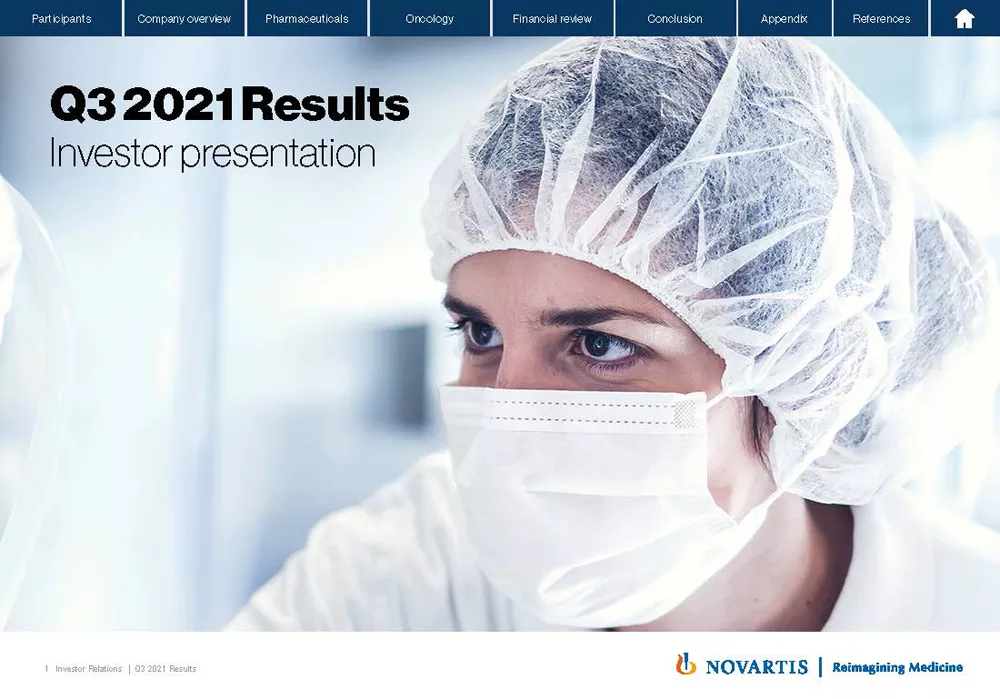
Thank you very much, and hello, everybody. I'd like to thank you for taking the time to participate in the Q3 Novartis Conference Call.
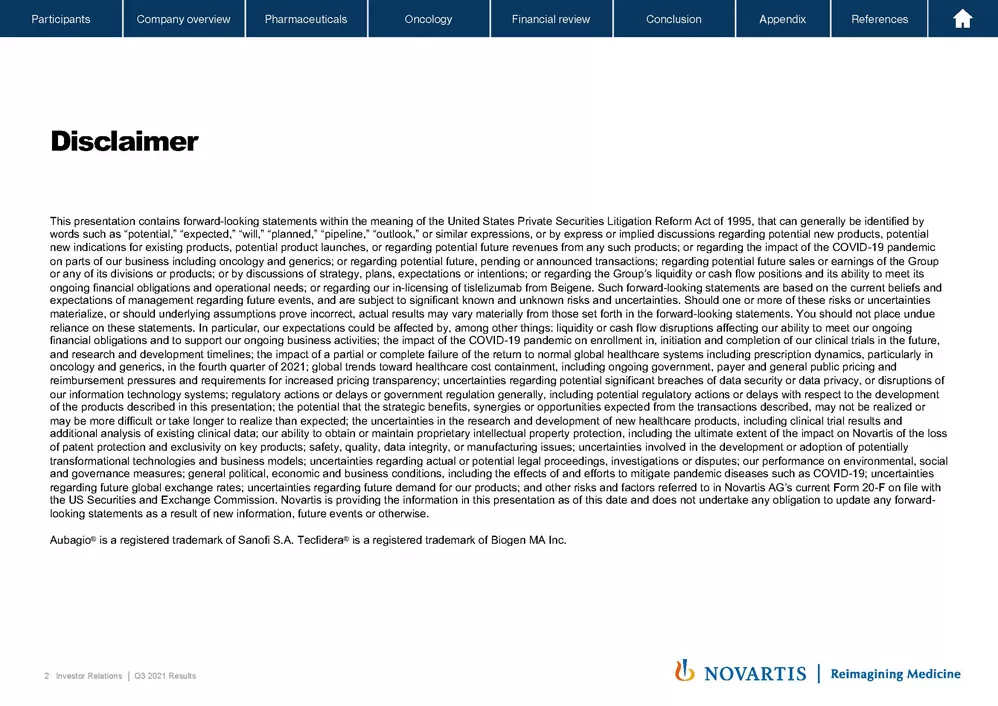
The information presented today contains forward-looking statements that involve known and unknown risks, uncertainties and other factors. These may cause actual results to be materially different from any future results, performance or achievements expressed or implied by such statements. For a description of some of these factors, please refer to the company's Form 20-F, its most recent quarterly results on Form 6-K that respectively were filed with and furnished to the US Securities and Exchange Commission – and with that, I'll hand across to Vas.
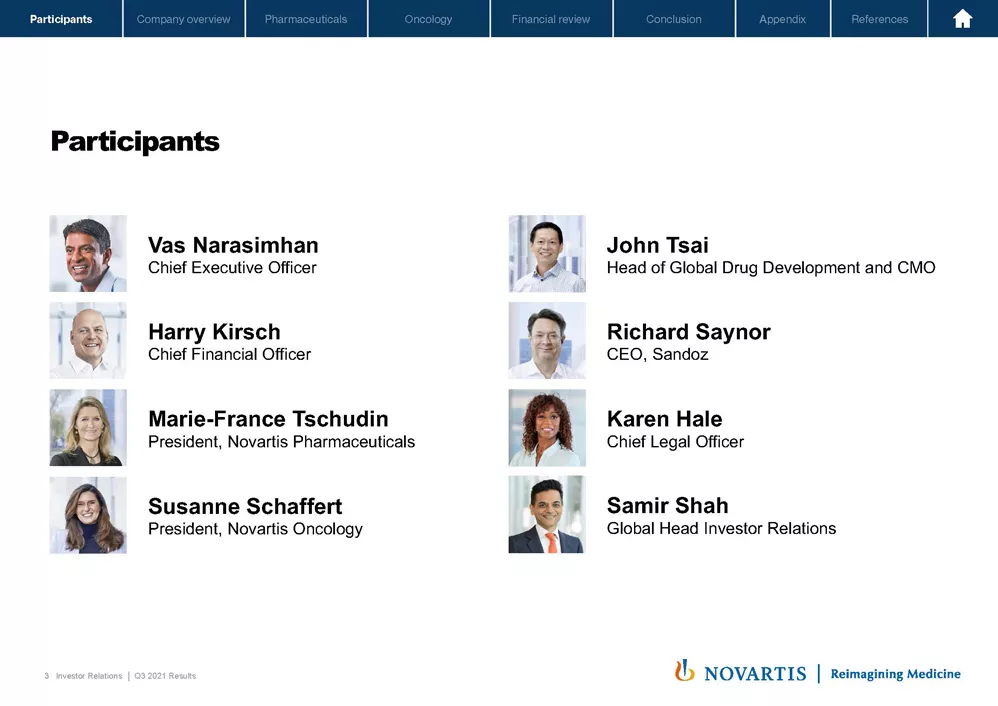
Thank you, Samir, and thank you for everyone for joining today's conference call. With me in the room, if I could have the slide up with our colleagues, on Slide 3, with me in the room, I have Harry; Marie-France; Susanne; John; Richard; Karen; and, of course, Samir, who you've just heard from.
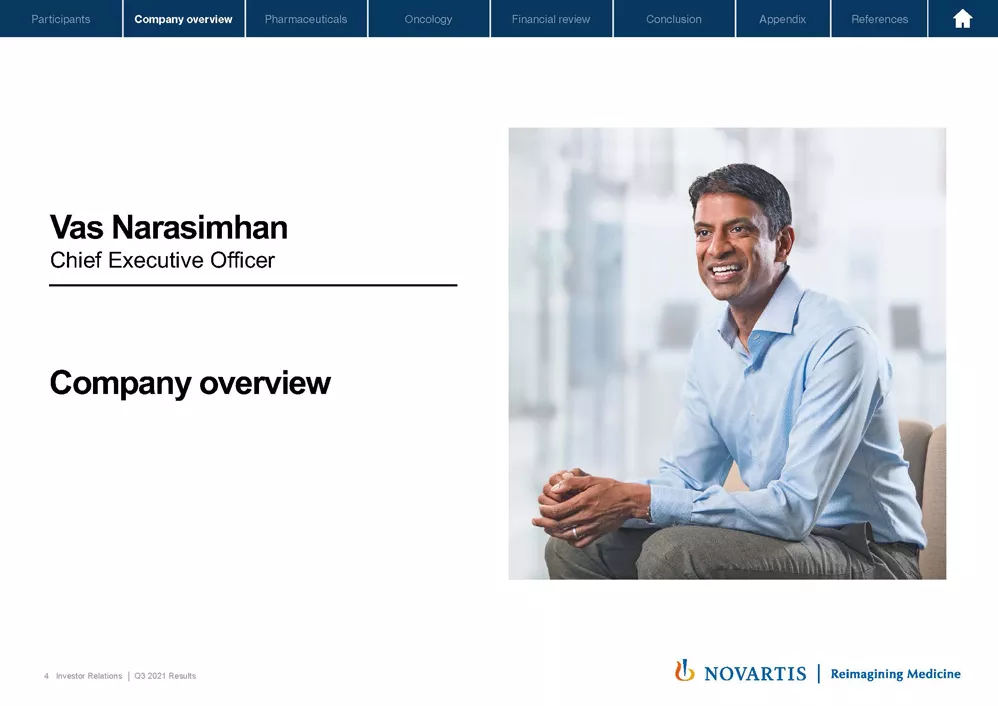
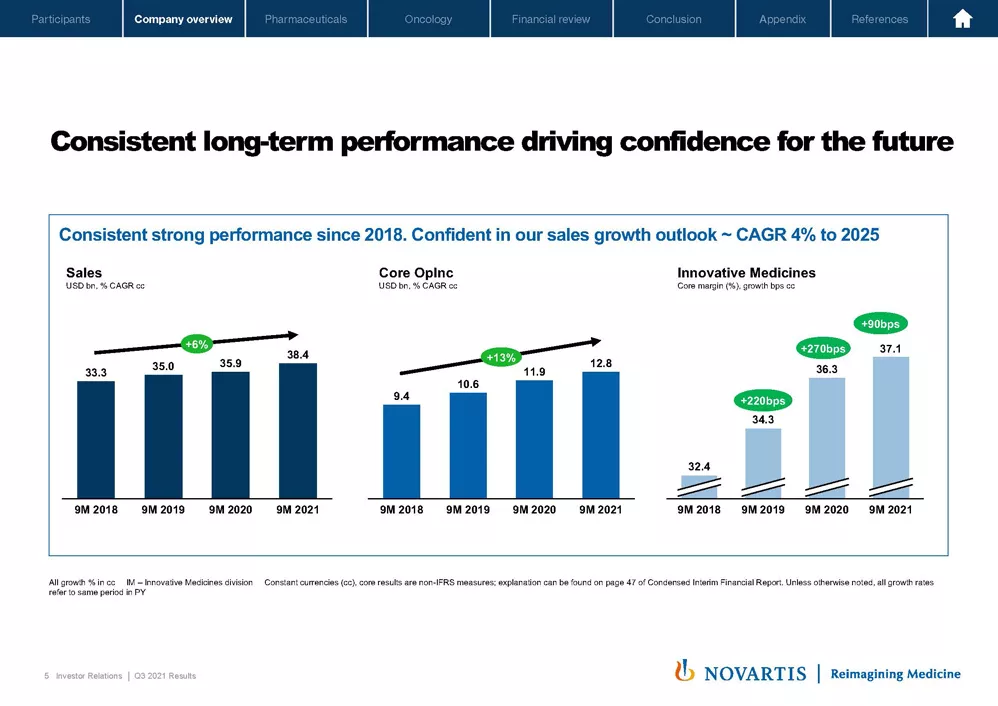
So turning to Slide 4 and then Slide 5. We wanted to start by taking a step back and really reflecting on how this quarter continues, I think, what has been a very strong trend for the company over the past 4 years. Looking at 9 months, for each of the years back to 2018, you see we've consistently demonstrated the ability to grow our sales at 6%, annual CAGR 13% on core operating income and a consistent expansion of our Innovative Medicines margins.
Now looking ahead, we stand behind our belief that we can continue to grow our sales over the coming period at a CAGR of 4%, driven by, first and foremost, our key growth drivers, which we'll talk more about over the course of this call; our strong mid-stage pipeline; and the continued investment we have on technology platforms, which we think over time will differentiate us and enable us to have a steady flow of innovations to drive growth.
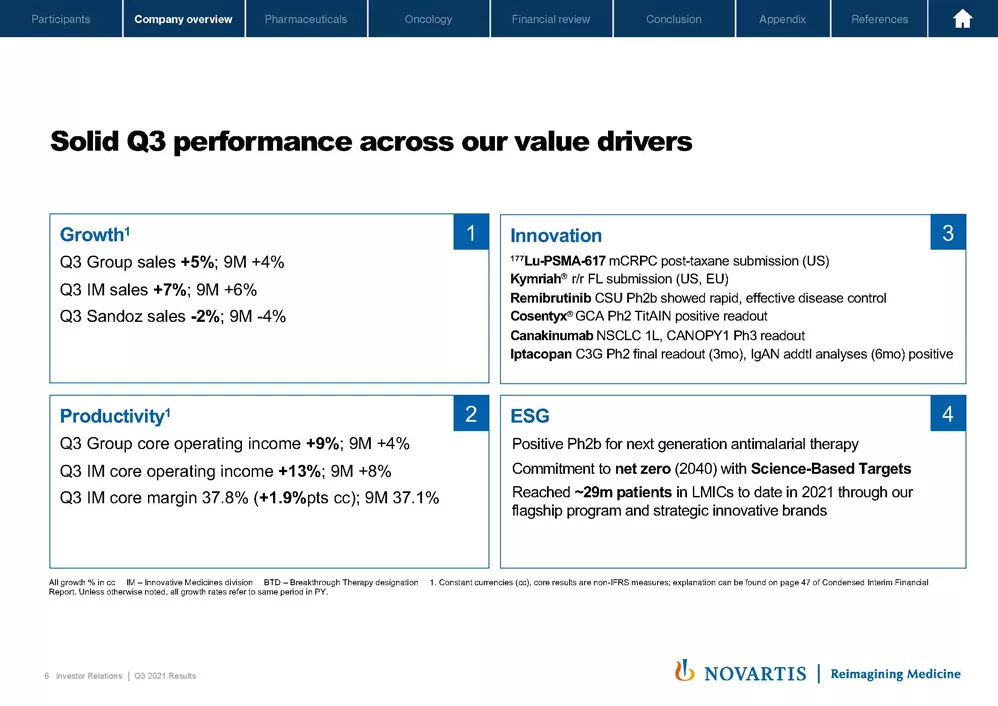
Moving to Slide 6. For Q3, we had strong performance across each of our 4 main value drivers. We'll talk about sales growth throughout the call, and Harry and our colleagues, Marie-France and Susanne, will give you more details. We had good productivity with our core operating margin now reaching 37.8% in IM.
On the innovation front, I'll go through some of the milestones in more detail later on. But I think it was a busy quarter for us with some negatives, but more positives overall on balance and we continue our journey on our innovation efforts. And then lastly, in ESG, we had our recent ESG Day where we laid out our longer-term ESG strategy, and we continue to have the ambition to not only lead in the biopharmaceutical industry, but also across large companies.
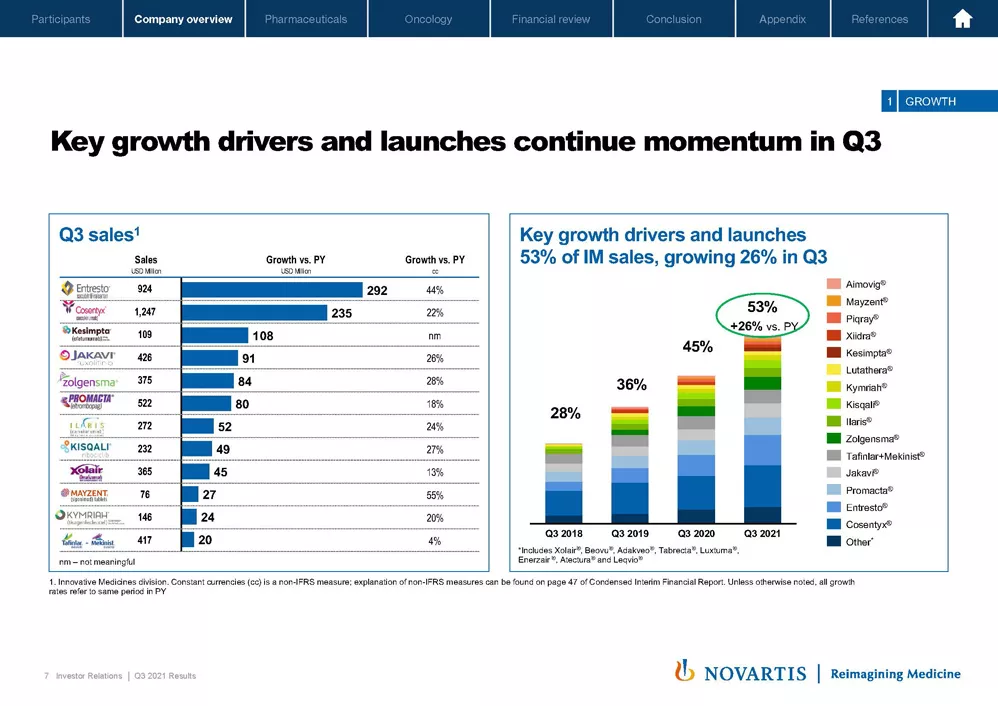
Now moving to Slide 7. Our key growth drivers and launches had a good momentum in quarter 3. We're very pleased with the performance. We'll go through some of the brands over the course of the call. But notably, we now have 53% of our sales in the quarter coming from these key growth brands, and that's up 26% versus prior year. And I think that demonstrates that we're a company that has replacement power, that can continue to generate innovations that overcome expiries and drive that consistent growth over time.
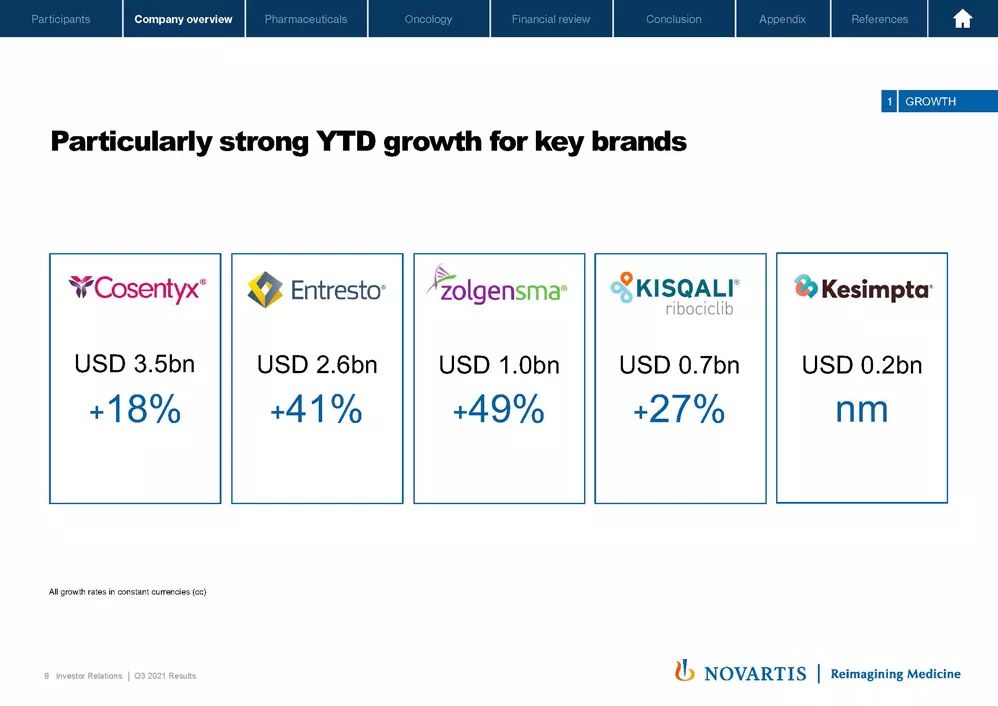
Moving to Slide 8. We had particularly strong growth on some of our key brands, including Cosentyx®, growing 18%, Entresto® was up 41%, Zolgensma® up 49%, Kisqali® 27%, and Kesimpta® continues on its solid and accelerating launch trajectory. Marie-France will go through that in a bit more detail.
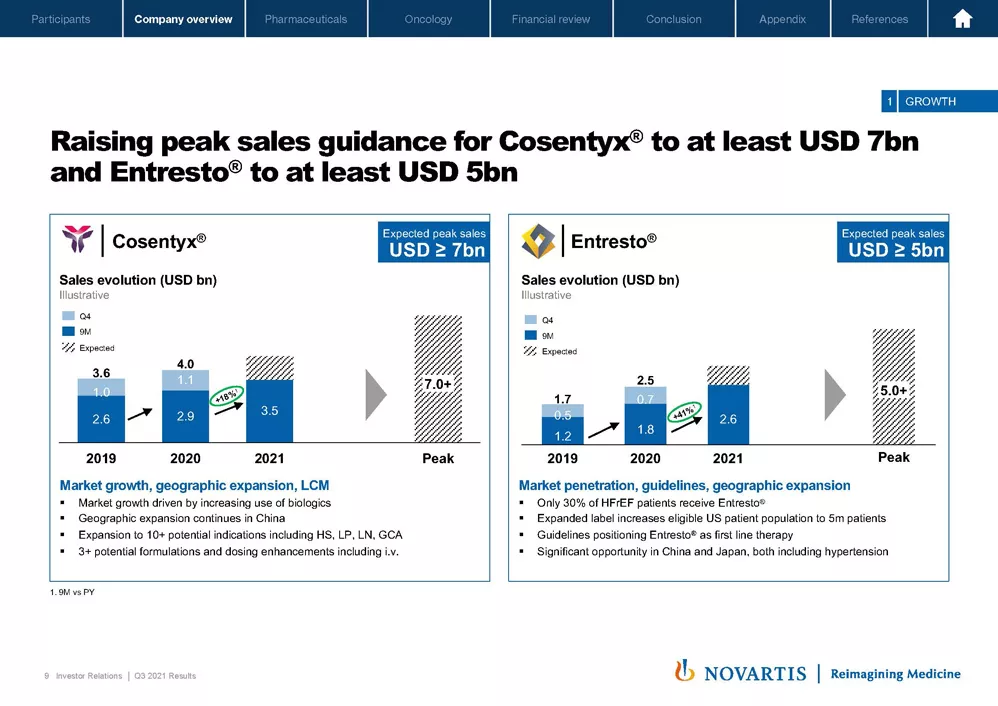
Moving to Slide 9. We announced this morning, we are raising our peak sales guidance for both Cosentyx® and Entresto®. So first, from Cosentyx®, and we'll go through this in more detail a bit later. We've raised our peak sales guidance to USD 7 billion. This is driven by market growth, geographic expansion as well as life-cycle management opportunities. And we expect this brand to continue to be a strong element of Novartis' story through this entire decade.
Now moving to Entresto®. We believe we'll continue to have strong growth driven by market penetration, guidelines and geographic expansion. Our peak sales guidance is consistent with our currently stated assumption of an LOE in 2025. However, we do have issued patents going out to 2027 and an additional group of patents that were recently issued out to 2033. And we'll continue to aggressively defend our IP to maximize the impact of this medicine.
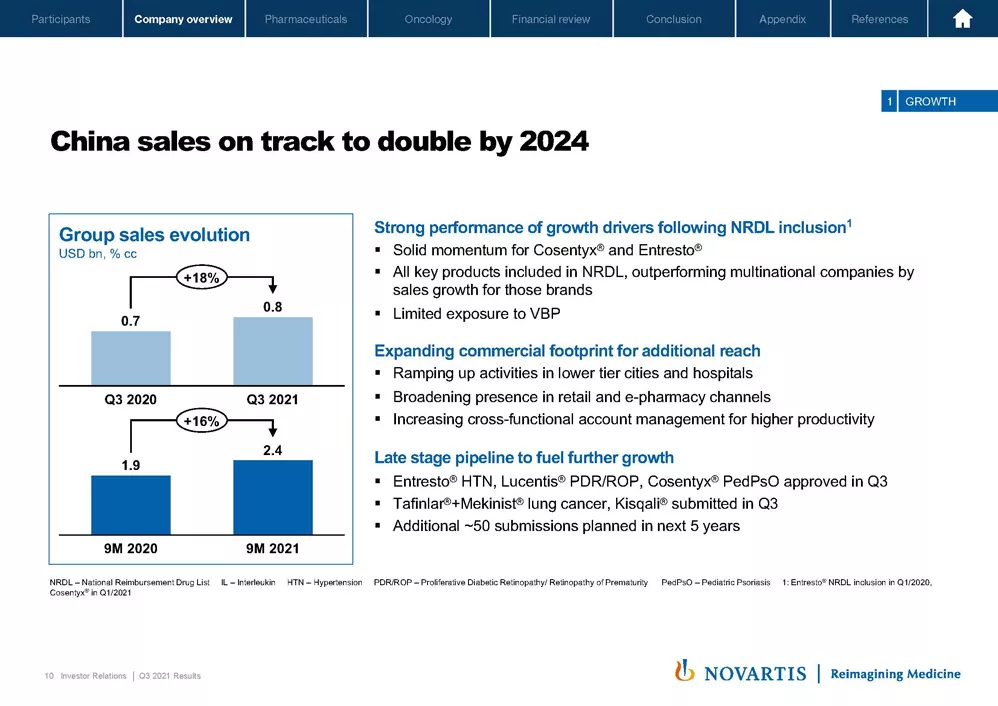
Now moving to the next slide. I also wanted to say a word on China, where we continue our strong growth trajectory, one of the leading multinationals in the market in China. We continue with a double-digit growth in the high teens, 16% and 18% on the quarter. This is driven by a few factors. One, the continued positive momentum we have on our growth drivers that have NRDL inclusion. And we believe we're outperforming other multinational companies for the sales growth of these NRDL-listed brands. We also have limited exposure to the volume-based pricing.
When you look at our commercial footprint, we've been expanding our commercial footprint to reach lower-tier cities and hospitals. And lastly, our late-stage pipeline continues to mature in China. We had some important recent approvals, Entresto® hypertension, Lucentis® in additional indications, and we have 50 additional submissions planned in the next 5 years. So we're confident we're on track to double our China sales from the 2020 base by 2024.
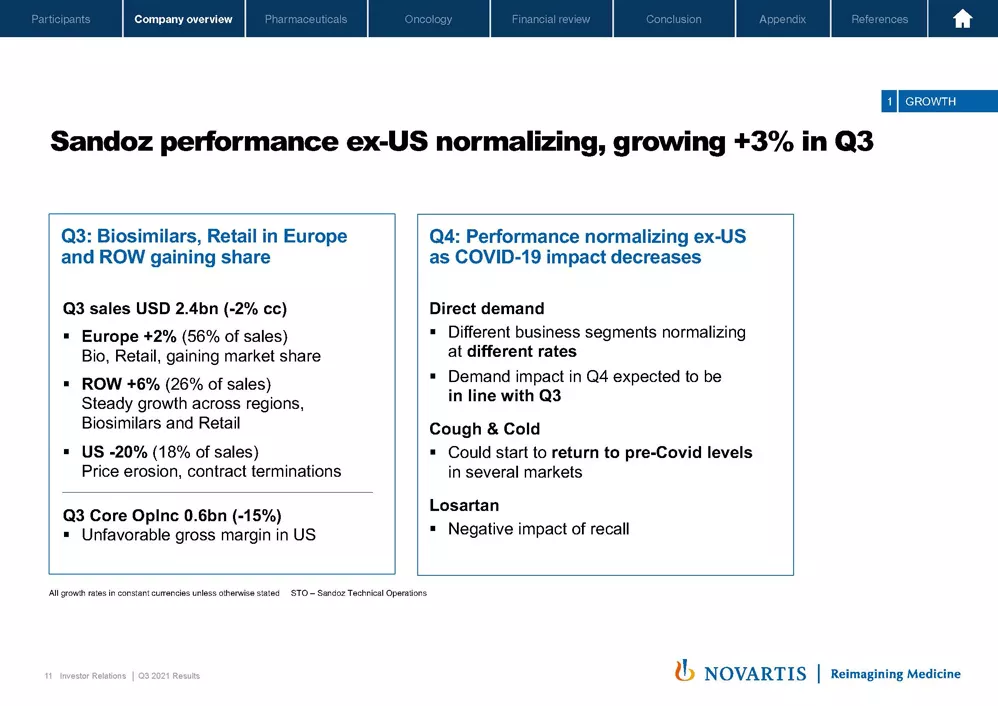
Moving to the next slide. Now turning to Sandoz. In Sandoz, we had a mixed quarter. We see in the ex-US dynamics normalizing, but a little more challenging environment in the US. So first, in Europe, we had a 2% sales growth. And this was really driven by both Biosimilars as well as Retail and a return to gaining market share in our key markets.
In the Rest of World region, we were up 6% with steady growth across regions. However, in the US, we did see a 20% decline. And this was driven by price erosion as well as contract terminations in our oral solids business. We also had an impact on core operating income. This is primarily driven by the unfavorable gross margins from the product mix in the US.
Now turning to Q4. We do expect performance to normalize in the ex-US, and we'll continue to work to stabilize the US. We expect our direct demand business segments to normalize, but at different rates. We continue to expect demand to be in line with what we saw in Q3. And we're hopeful that we'll see a cough and cold season that returns to pre-COVID levels. We did have a minor impact as well from a negative impact from Losartan in Q3, and we continue to expect to see some of those negative impacts in Q4.
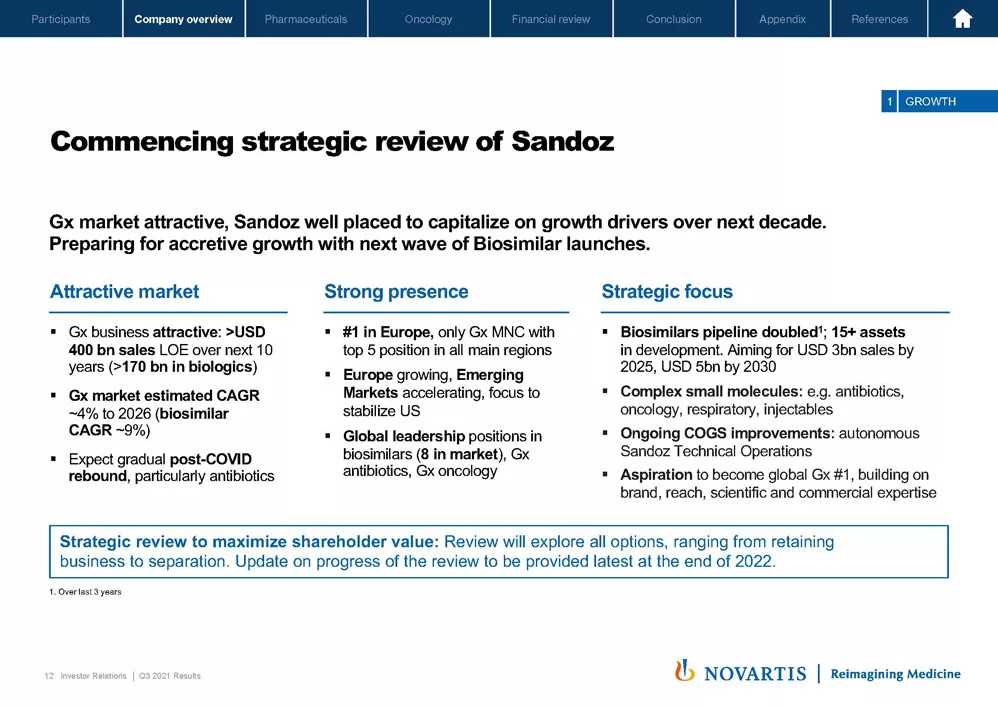
Now moving to the next slide. We did announce this morning that we're commencing a strategic review of Sandoz, consistent with what we outlined a few years ago. We had stated that we wanted to create a more autonomous Sandoz within Novartis that would give us the optionality to ultimately determine whether is Sandoz best owned by Novartis or by our shareholders or another party. And we believe the Gx market is attractive. We think Sandoz is well placed to capitalize on its growth drivers over the next decade. And we think Sandoz is also well placed to really be a leader in the next wave of biosimilars launches.
When you take each of those in turn, attractive market, USD 400 billion of sales going to LOE over the coming decade, a CAGR of 4%, Sandoz with a #1 position in Europe and in biosimilars as well as a leading position in areas like antibiotics and a clear strategic focus that Richard and his team have put in place. We have a very strong biosimilars pipeline with 15 assets in development, aiming for USD 3 billion of sales by 2025 and USD 5 billion by 2030, a clear strategy in complex, small molecules and ongoing margin improvements primarily through improved COGS through our technical operations unit.
So we expect to conduct this review over the coming period, and we would plan to provide an update on progress latest by the end of next year. It is notable that Sandoz is more integrated into Novartis than Alcon was historically. And so there are important considerations we'll need to work through from an IT and business services standpoint to really enable us to make the best decision.
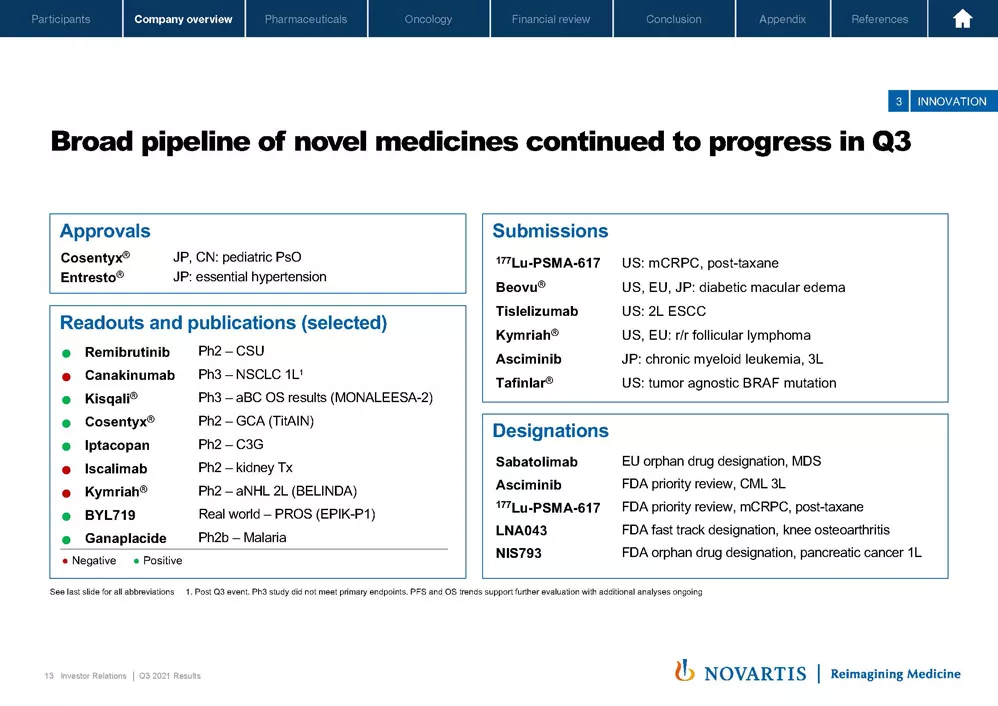
Now moving to Slide 13. From a pipeline standpoint, we had a busy quarter, some approvals, a number of readouts, many readouts that went our way, but also important readouts that didn't go our way. We acknowledge those and are working to learn from them to continue to improve our pipeline performance. But on balance, we would say we continue to be at the industry benchmarks or better in terms of pipeline success rates by phase.
From a submissions standpoint, a number of submissions went in. And I think importantly, we received 2 designations, priority reviews for both asciminib and Lu-PSMA-617. Both of those reviews are ongoing and should enable a launch in the relatively near term.
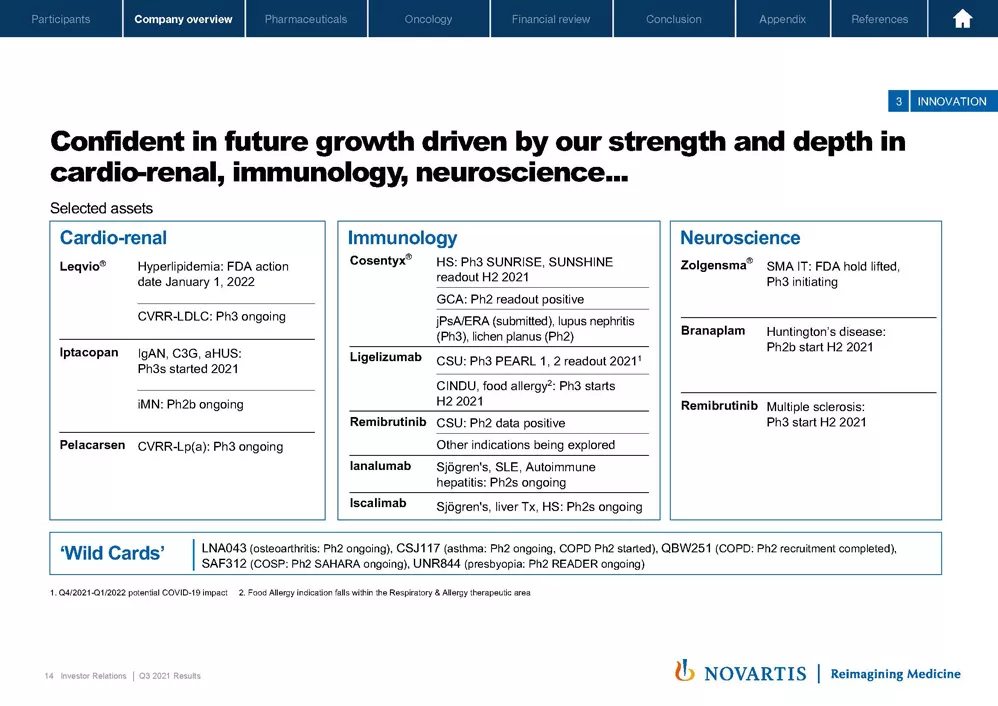
And moving to Slide 14. Going a bit deeper, and we've reframed these next 2 slides rather than looking at Pharma and Onco to really break it out by business franchise and global franchise of the various businesses. So starting in Pharmaceuticals and Cardio-renal where, of course, we build on the strong position we have with Entresto®. Leqvio®, we remain on track for an action date in January 1. We have good discussions with FDA, are continuing to progress the assessment of our Austrian facility. No issues have been flagged. So we remain on track for that approval.
Iptacopan, we continue to have solid progress on this medicine with Phase III started in IgAN, C3G and atypical hemolytic uremic syndrome. We also disclosed in our quarter that both the final readouts for both C3G and IgA nephropathy, which followed these patients for a bit longer, continued the trend of improving renal function. Pelacarsen continues to perform well in its Phase III.
From an Immunology standpoint, we announced today that Cosentyx® had a positive Phase II readout versus steroids standard of care for giant cell arteritis, and we've moved now to begin a Phase III program. And of course, the hidradenitis readouts are on track as well as the other Phase III programs.
Ligelizumab remains on track for its readout, and we'll talk about remibrutinib. I did want to highlight we see very good data, mid-stage data for ianalumab, which is our anti-BAFF receptor antibody. And we'll be presenting more data in the coming quarters on this medicine, but we're excited about its potential in a range of autoimmune as well as hematological indications.
Turning to neuroscience, the SMA intrathecal AVXS-101 intrathecal FDA hold has been lifted as we previously disclosed, and the Phase III now is initiating. It’s a global Phase III program covering 2- to 18-year-olds. Branaplam, our splicing inhibitor, splicing modulator, I should say, for Huntington's disease, has its Phase IIb now starting with all the relevant regulatory clearances achieved. And we will announce and we've announced, and I will talk a bit more about remibrutinib in a moment.
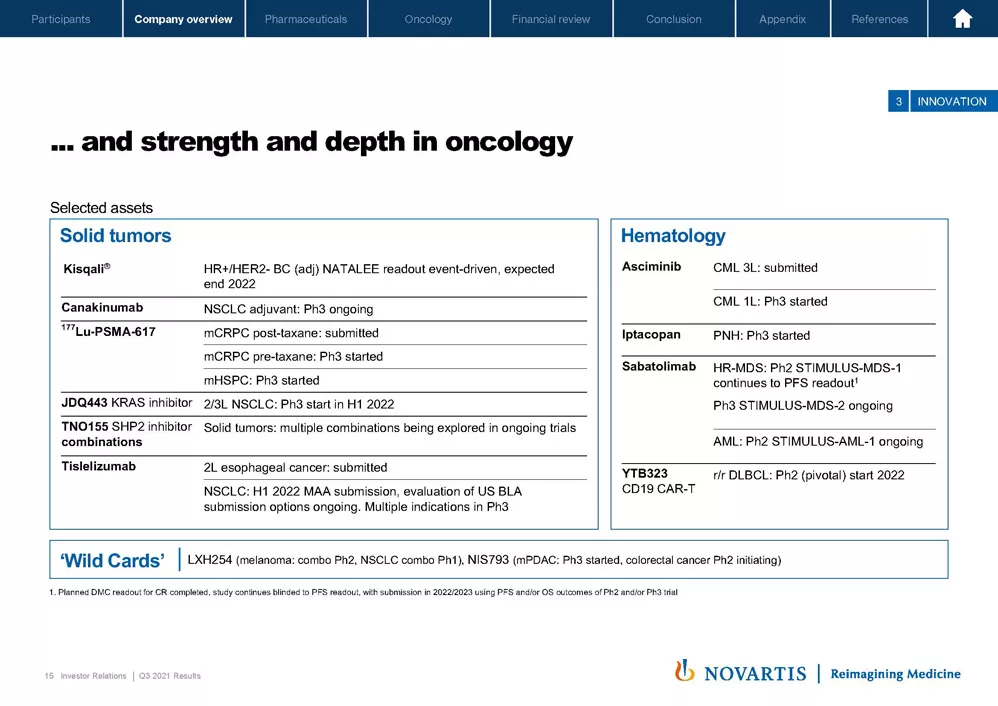
Turning to the next slide from an oncology standpoint. Here, we had, of course, a number of events. We'll talk about Kisqali® and canakinumab. Lu-PSMA, we've already mentioned. I did want to flag, we've started now both our earlier-stage studies in the pre-taxane as well as the hormone-sensitive metastatic settings and are continuing to evaluate to potentially move this medicine into earlier lines.
We did announce as well that JDQ443, which is our in-house KRAS inhibitor, has had a good PK, good dose finding. We think it's a very good profile for this medicine and are now moving it into Phase III studies in non-small cell lung cancer, but then we'll also look potentially at other indications. And this enables us to have in our own hands, our own combination of a KRAS inhibitor and a SHP2 inhibitor. Our TNO SHP2 inhibitor is now in a number of early-stage studies looking at combinations. And we'll hopefully be able to present more data on this in the early part of next year.
Turning to hematology. Our first-line study for asciminib now has also started. Our PNH for iptacopan is progressing well. Our sabatolimab programs remain on track. And importantly, now with YTB, our next-generation CD19 CAR-T, we've seen very good data in the early phases, which we'll present at ASH, along with our multiple myeloma next phase CAR-T therapy. And we plan to start the pivotal studies in 2022.
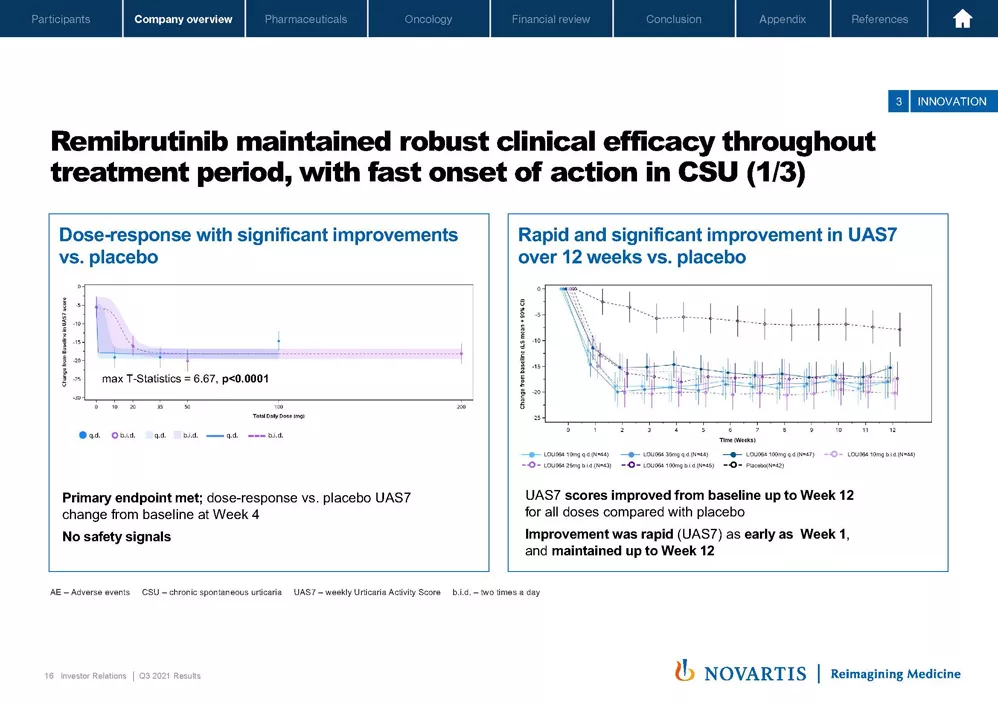
So moving to the next slide. Just wanted to say a few words on remibrutinib. This, I think, is a really well-designed medicine. We have excellent chemistry at Novartis. And our scientists have worked to really create a highly selective, potent and safe covalent BTK inhibitor. And when you look at the data in CSU, we're the first BTK inhibitor to be able to demonstrate the kind of data that you see on these slides.
First, a very good dose response with significant improvements versus placebo. And you can see the statistics here are very compelling with no safety signals. Then when you look at the improvements in the relevant urticaria score over placebo, you can see across the dose range, we see a clear improvement versus placebo. And that improvement was very rapid as early as week 1 and maintained through week 12, the endpoint of the study.
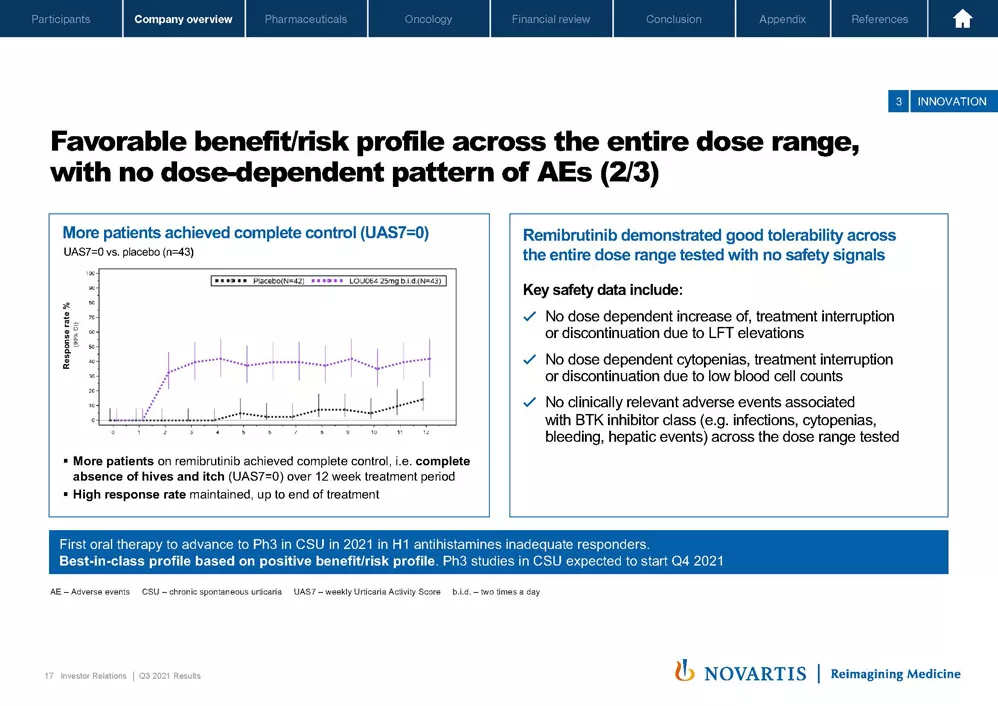
Moving to Slide 17. When you look at the complete control that patients on remibrutinib b.i.d. were able to achieve versus the placebo group, very high response rates that were consistently maintained over the course of the study, I think, showing the potency of the drug. But in terms of differentiation, particularly in dermatology as well as in multiple sclerosis, we were really pleased with the safety profile of this medicine, which we think will be critically important.
One, there was no dose-dependent increases or treatment interruptions or discontinuations due to LFT elevations, no dose-dependent cytopenias or treatment interruptions for low blood cell counts, and no clinically relevant adverse events associated with what have been historically associated with the BTK inhibitor class across the entire dose range tested. So overall, we think this is a potential best-in-class profile for CSU, positive benefit/risk, and those Phase III studies are in the midst of starting right now.
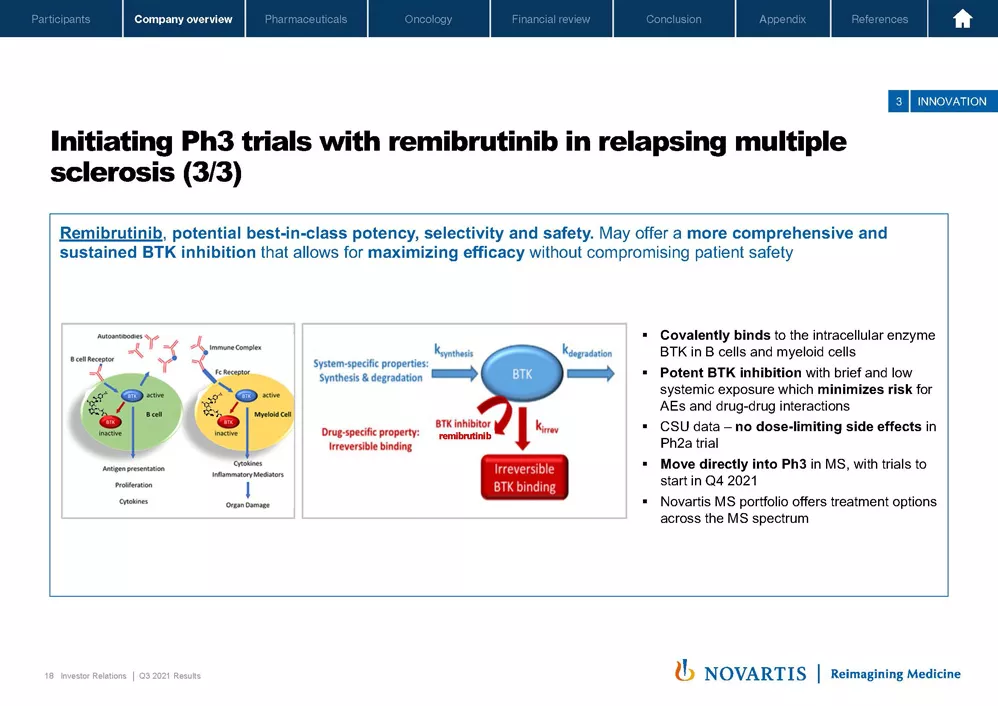
Moving to Slide 18. And as mentioned, we're now initiating Phase III trials with remibrutinib. We understand that we are behind some of our competitors. But we believe our expertise in conducting large-scale RRMS studies gives us the ability to close the gap. And importantly, we think for neurologists, what's really important is they have a very safe medicine that is also high efficacy, and we think we can deliver that with remibrutinib. And what will this allow us to do? We've already got the all-clear to move ahead into our Phase III studies. And what this allows us to do over the longer term is build on our multiple sclerosis portfolio, Gilenya®, Mayzent®, Kesimpta® and now adding eventually, assuming success, remibrutinib.
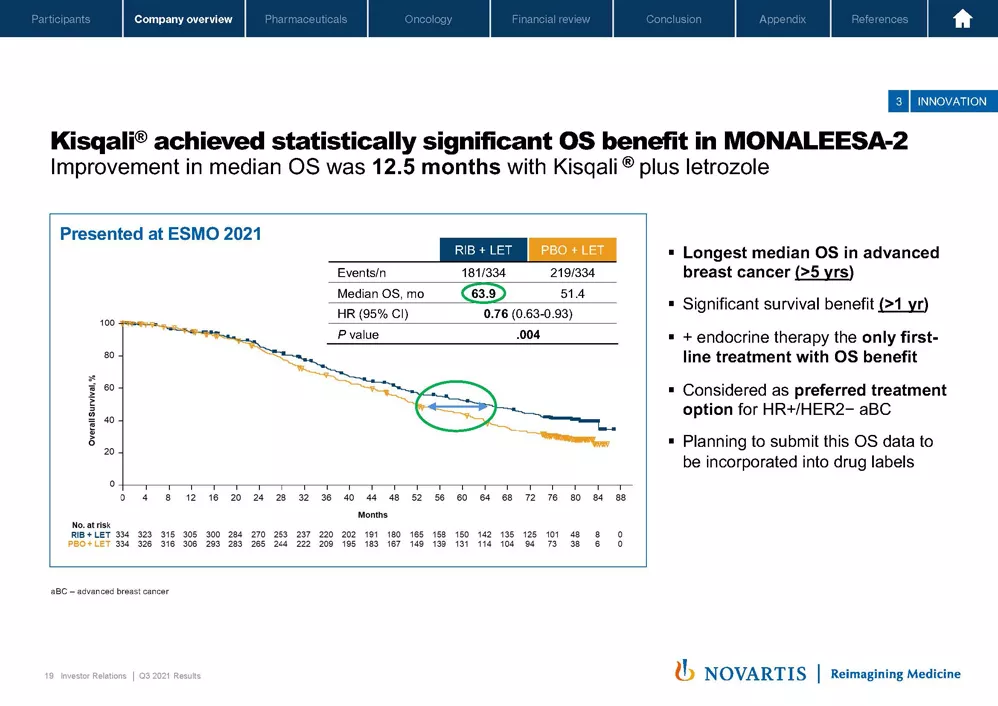
So moving to Slide 19. You also saw in the quarter, Kisqali® achieved statistically significant OS in the MONALEESA-2 study, the third study where Kisqali® in the metastatic setting has demonstrated a significant overall survival benefit, that benefit now up to 5 years. It's really, we believe, should be the preferred treatment option for these patients given the compelling OS data that's been demonstrated. We plan to submit this OS data into our labeling in the relevant geographies.
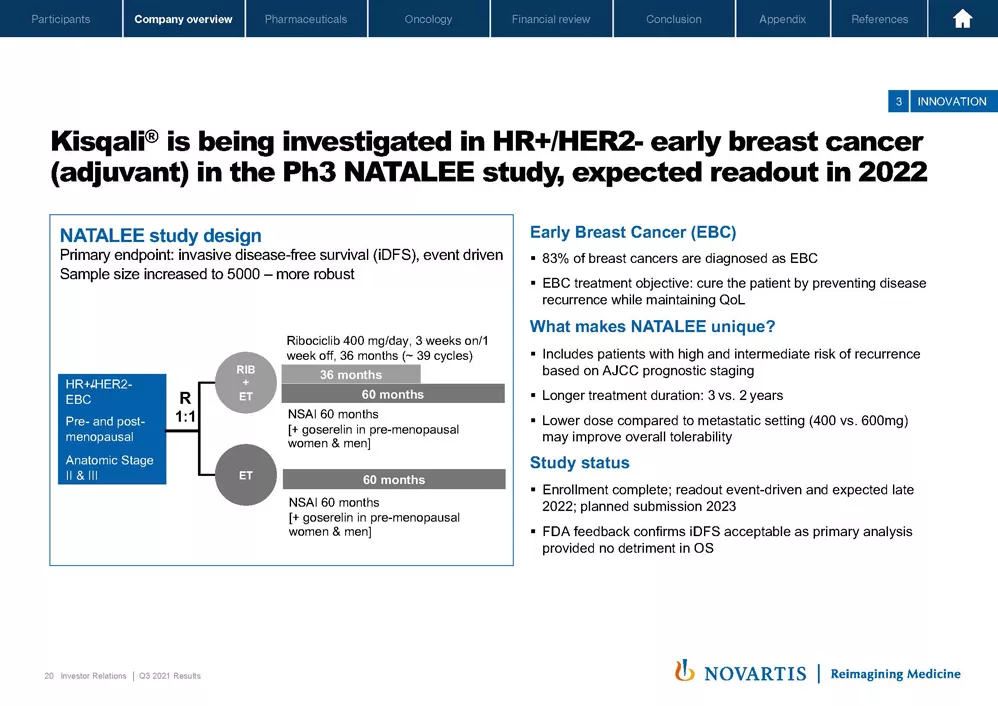
Moving to Slide 20. I just wanted to say a word as I know there's a lot of interest now in the adjuvant readout, which we expect in 2022. It's on track, fully enrolled. Just to remind you, there's some unique elements of this study. One, it includes patients at high and intermediate risk, which is a larger patient population than some of our competitor studies. And the way we have designed the study, it's to base enrollment on the prognostic staging from the AJCC. A little bit different than the Ki-67 that has gotten a lot of attention, but we believe and with regulatory sign-up, a very relevant prognostic staging to really ensure that we enrich for the risk of recurrence in this study.
We have a longer treatment duration of 3 years versus 2 years. We lowered the dose to make sure this was manageable for patients in the adjuvant setting to overall improve the tolerability. So as I said, enrollment complete. It's an event-driven study. We expect a late '22 readout. And feedback from FDA, which we reviewed again, says that the iDFS endpoint is acceptable as the primary analysis provided there's no detriment in OS. And we're, of course, taking that into account as we see the various readouts over the course of next year.
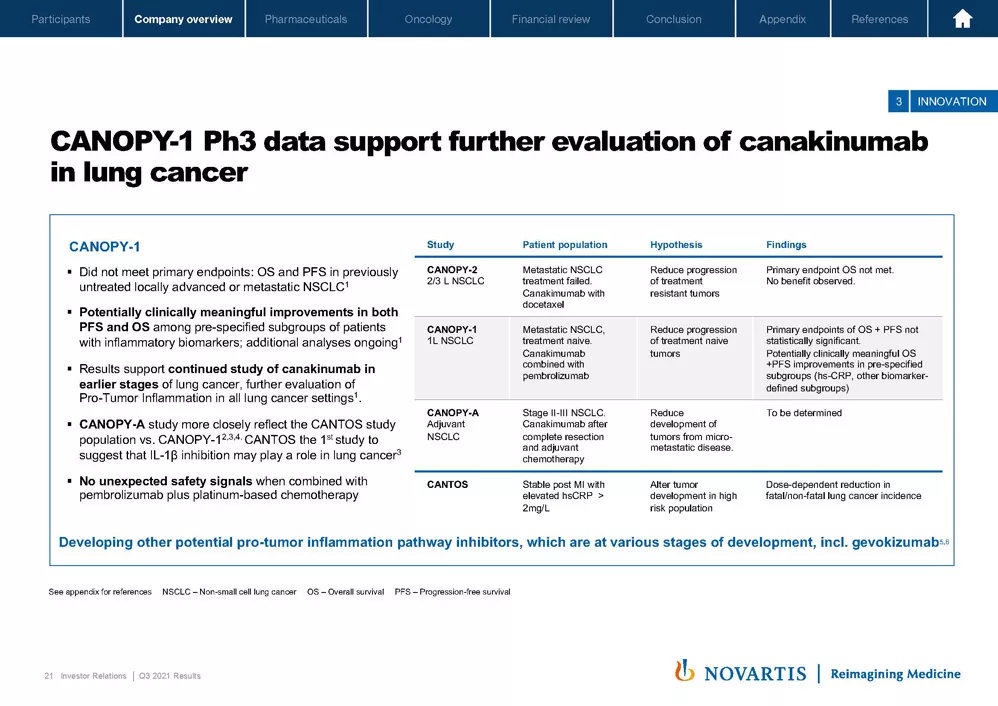
Moving to Slide 21. Now I wanted to turn to CANOPY. And if you'll indulge me, I'll just take a few minutes to explain the data that we released yesterday to make sure it's clear. And then we'll, of course, be happy to take your questions. The CANOPY program is based on the results we saw in CANTOS, where we saw 60% to 70% improvement in the incidence and mortality of lung cancer in a cardiovascular trial. This was based on a pretty good understanding that IL-1 beta as well as hsCRP are very relevant in the tumor microenvironment for lung cancer as well as in other inflammatory cancers.
The CANOPY-2 study was in the second line there. We didn't see any signals of efficacy overall. And there, of course, as you saw at ESMO, the trend was not positive with canakinumab versus the control arm of chemo. In this study, while we did not meet our primary endpoints of OS and PFS in previously untreated, locally advanced, metastatic non-small cell lung cancer, in the overall population, we did see a positive trend though not statistically significant.
Importantly, we did see potentially clinically meaningful improvements in both PFS and OS. These improvements in these prespecified subgroups and biomarker-driven subgroups were nominally statistically significant. And the upper bound of the confidence interval specifically did not include one. And we saw treatment effects that were meaningful in our view. However, we don't believe at this point in time that this would constitute a fileable program.
Now what we do believe is these results support the continued study of canakinumab in earlier stages of lung cancer. We believe they also support further evaluation of pro-tumor inflammation because the signals we saw were meaningful. On CANOPY-A, the study, we believe, more closely reflects the CANTOS study, it remains a high-risk study to be clear. But nonetheless, we think it's important to complete this study to really understand if there's a possibility to replicate the remarkable findings of the CANTOS study. It's so important for patients if we could actually demonstrate that.
Now in addition, we wouldn't want to highlight, as I think there has been confusion about this. In this study, we did not see meaningful differences in the safety profile of the canakinumab arm versus the control arm of PD-1 plus chemo. So that kind of gives you an overview.
We would note as well, we have a number of other pro-tumor inflammation medicines, oral medicines as well as gevokizumab, which is another anti-IL-1 agent that has LOE into the mid-2030s. And of course, we're evaluating that medicine in a few other cancer settings and we'll evaluate as well if there is a credible case to do anything further in metastatic non-small cell lung cancer.
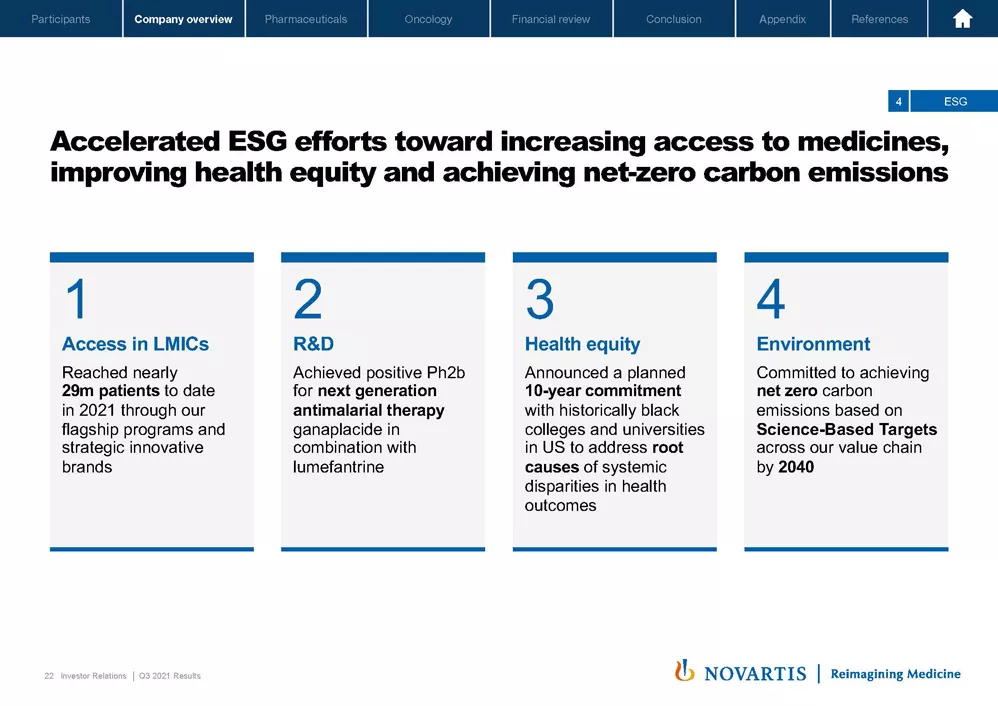
Now moving to Slide 22. Lastly, before handing it over to Marie-France, we've accelerated our ESG efforts; 29 million patients reached; a next-generation malarial therapy now entering Phase III studies; a 10-year commitment to really support addressing health inequities and health disparities in the United States; and we've committed to net 0 carbon on top of all of our other environmental commitments using science-based targets to achieve by 2040 and consistent with many of our other large companies that we'll be announcing these at COP26. And with that, I will hand it over to Marie-France.
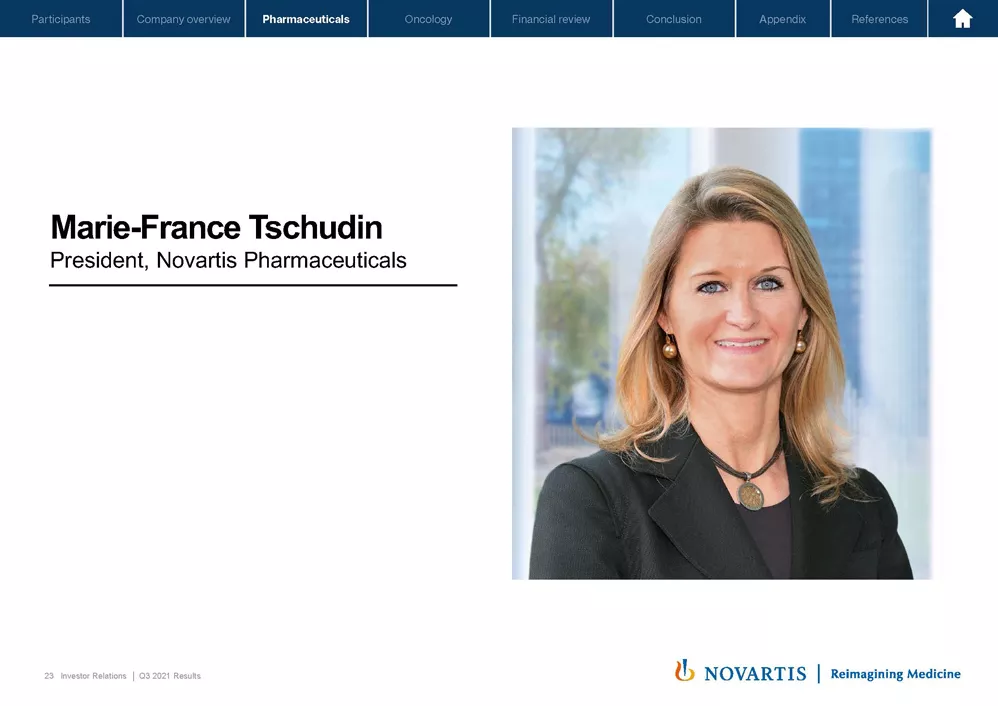
Thank you, Vas.
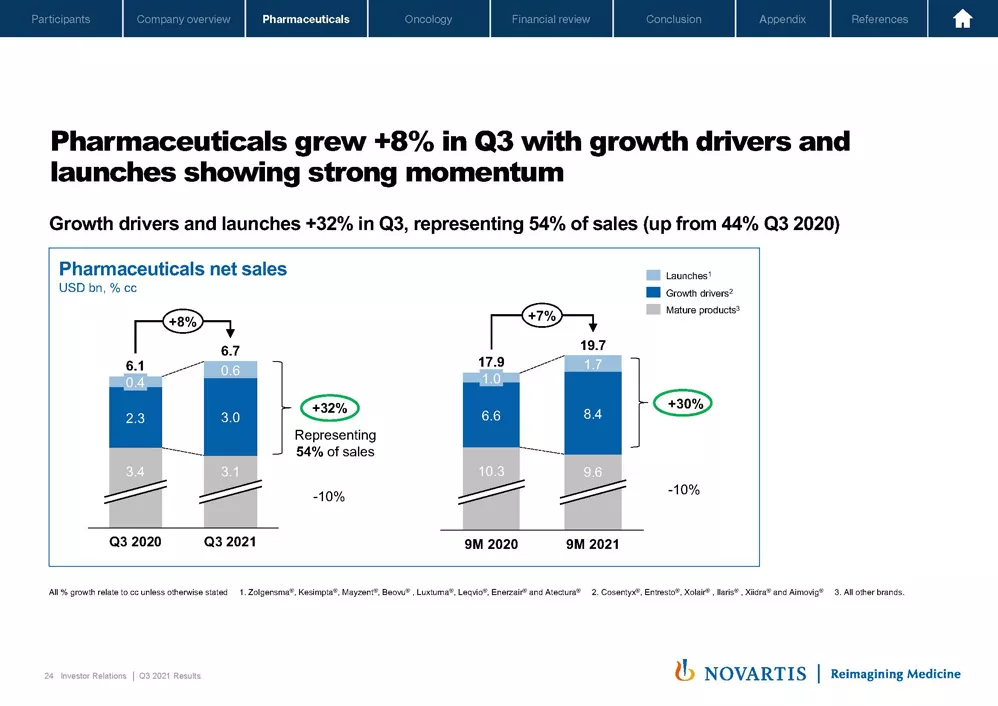
So moving on to Slide 24. Good morning, good afternoon to all. It's my pleasure to share the results of the Pharmaceuticals division for Q3. Sales grew 8% this quarter, driven by a clear focus of our launch drivers, our growth drivers and supported by the solid execution across geographies.
As you can see, the growth drivers and launches have strong momentum. We're growing 32% and now they account for 54% of sales. This is 10 points above prior year and in line with our strategy. Looking at year-to-date, you can see us accelerating our momentum, and we're on track to have a strong finish to the year.
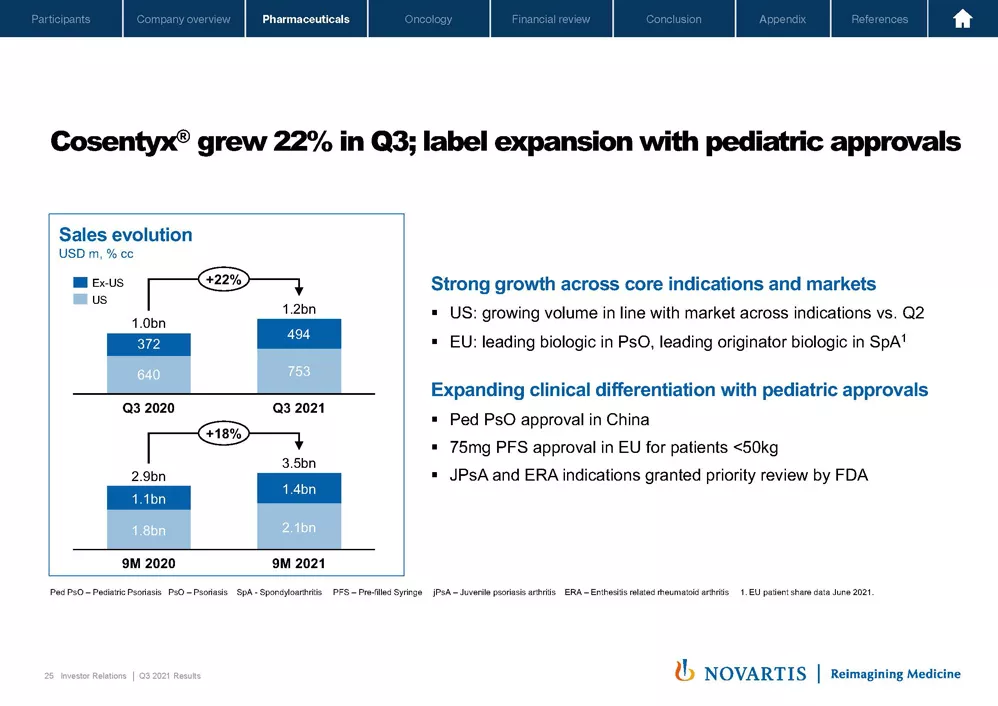
Moving on to Slide 25. Cosentyx® grew 22% with solid contribution from both dermatology and rheumatology. In the US, we're growing volume with the market. We're holding our leadership position in Europe. And in China, we're leveraging our NRDL listing. China is now our third biggest market. We've also strengthened our evidence base with multiple pediatric indications, further reinforcing the proven efficacy and safety of Cosentyx®.
To maintain our momentum in Q4 and beyond, we remain focused on our competitiveness in the field, the flawless execution of our marketing teams and the activation of 2 key groups of patients, those with PsO/PsA comorbidity that need strong efficacy in both skin and joints; and the axial SpA patients who can benefit from all-in-one release.
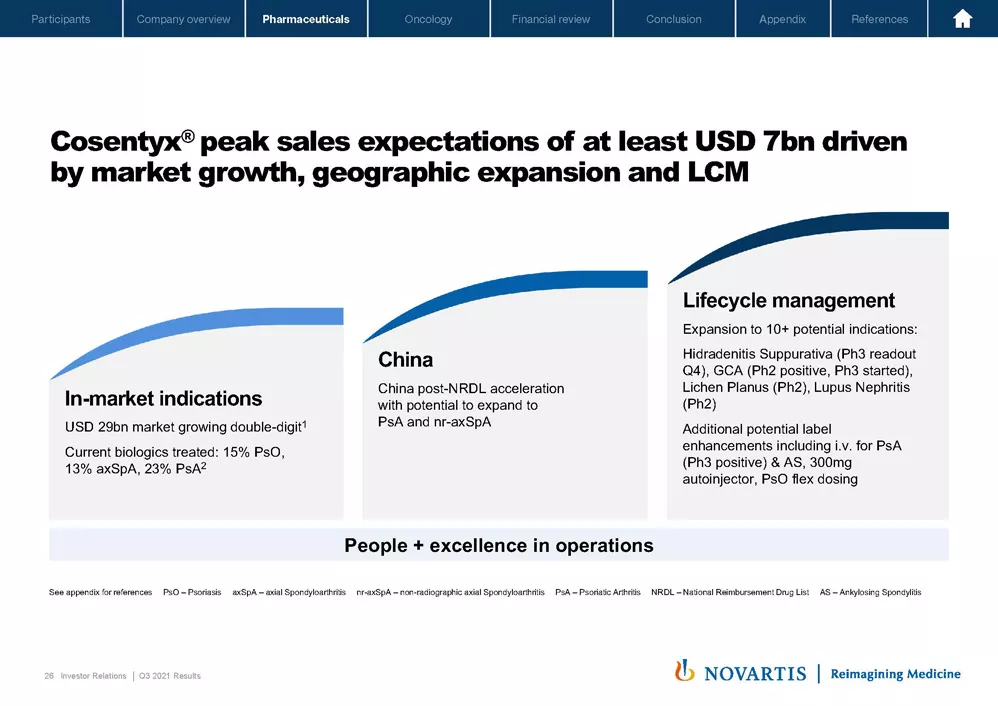
So I move on to Slide 26. While Cosentyx® has been on the market for 6 years, every year is a launch year. Cosentyx® has approved across 5 indications, all of them have low biologic penetration. With a strong value proposition and evidence base, Cosentyx® will continue to capture growth. Cosentyx® is also the only IL inhibitor with NRDL listing in China. We see strong growth potential in this market.
We have an ambitious life-cycle management plan, which is starting to deliver. We've seen positive readouts for giant cell arteritis and our IV formulation in Q3. We also expect data for hidradenitis suppurativa in Q4. Overall, we're looking at a potential of 10-plus indications in areas of high unmet need and an ambition to double the number of patients on Cosentyx®. This gives us confidence that we can grow Cosentyx® to at least USD 7 billion.
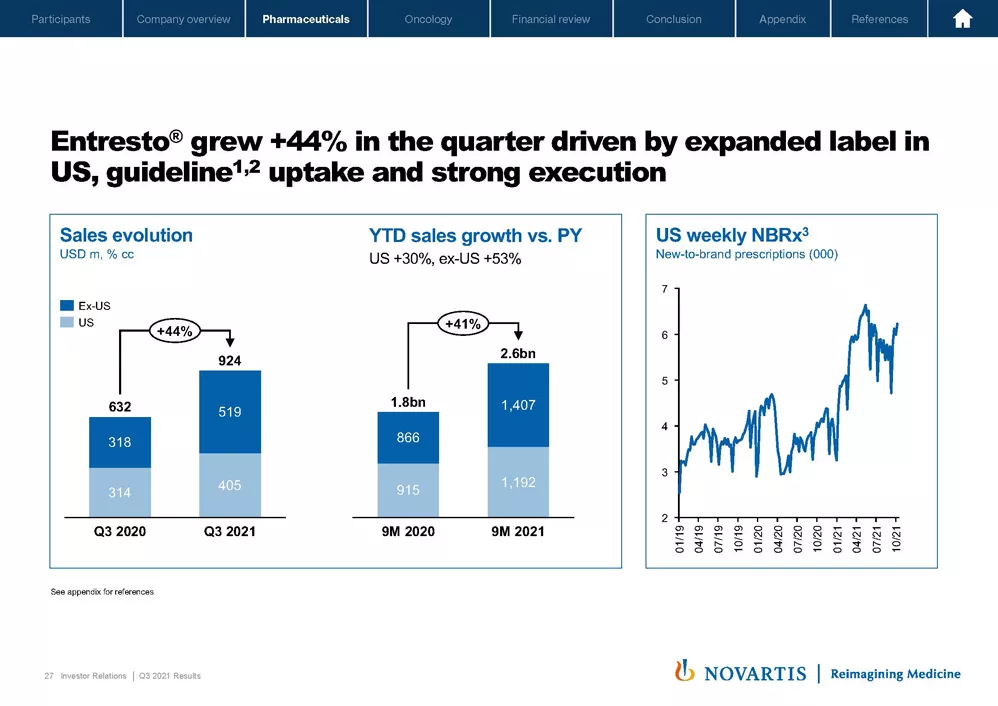
Moving on to Slide 27. Entresto® grew 44% in the quarter, reaching USD 2.6 billion year-to-date. The ACC and ESC first-line recommendations for Entresto® are translating into penetration gains and the expanded US label is driving NBRx growth and uptake in primary care.
In Asia, China continues to deliver strong growth on the back of our NRDL listing, and Japan is gaining traction. Both have acceleration potential based on our recent approvals in hypertension. As we pull through the US and the EU guideline recommendations and promote the expanded label in the US, we're well set up to maintain growth in Q4.
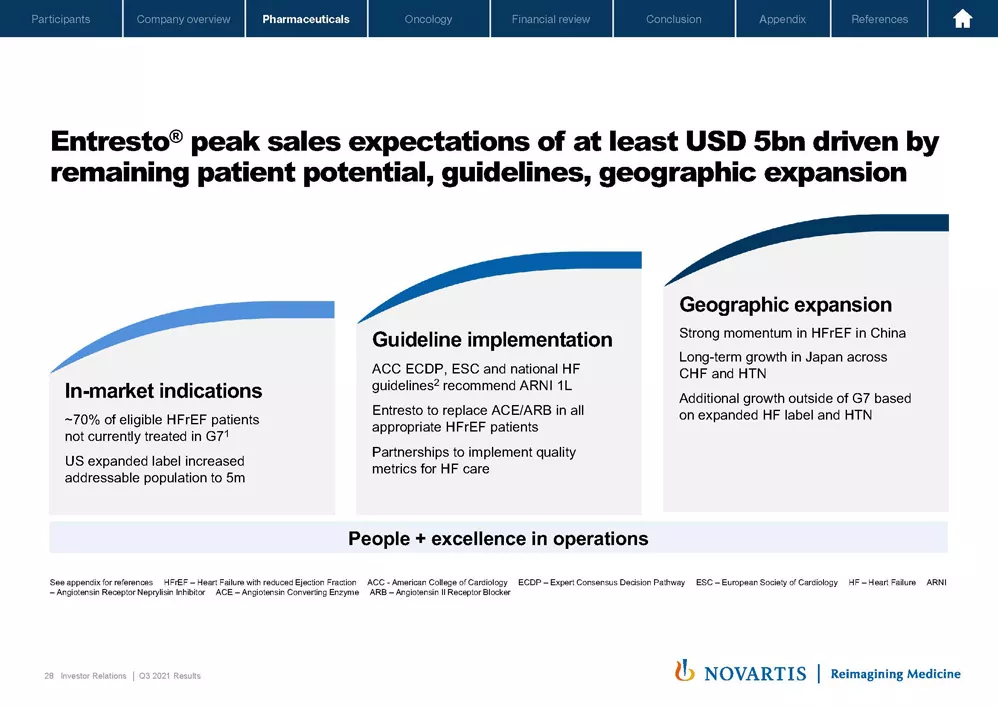
On Slide 28, if we think about the future story of Entresto®, it continues in line with our existing trend. We know that there remains significant patient potential. We have 4 million patients on treatment with Entresto® today, yet 70% of eligible patients can still benefit. In the US, where we have a broad chronic heart failure label, 85% of addressable patients are still on prior standard of care, and that makes ACE and ARB our clear competitive focus. With the recent guideline changes positioning Entresto® in first line, we now have an opportunity to drive broader and earlier adoption of Entresto® globally. So overall, we're bullish about the continued growth of Entresto® to at least USD 5 billion.
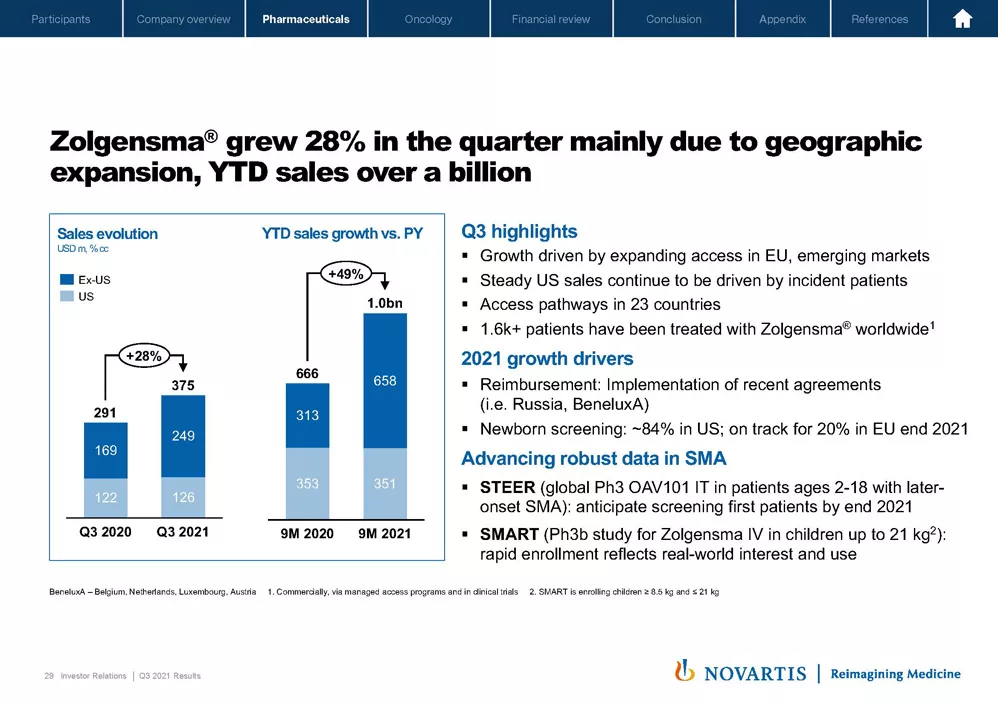
If I move on to Slide 29, Zolgensma® had a strong quarter and has just surpassed USD 1 billion in sales for the year. In the US, we're treating over 90% of babies according to our label due to the high rates of newborn screening. In Europe, we had strong uptake in Germany and Italy, and we saw a bolus of sales in the UK following reimbursement. We expect we've seen the bulk of this in Q3, but we have also reached agreement on reimbursement in Russia and a number of smaller EU markets.
So if we look ahead, we see 4 key drivers of future growth: New markets with Egypt, Saudi Arabia, BeneluxA expected to contribute in Q4; increasing newborn screening so that we can treat patients early on when the benefit of gene therapy is the greatest; heavier patients, our SMART study aims to drive confidence in Zolgensma®'s value across the full EU label; and intrathecal. Following the alignment of our Phase III study design, we're now one step closer to bringing IT to patients aged 2 to 18 and thus ultimately address the full spectrum of SMA.
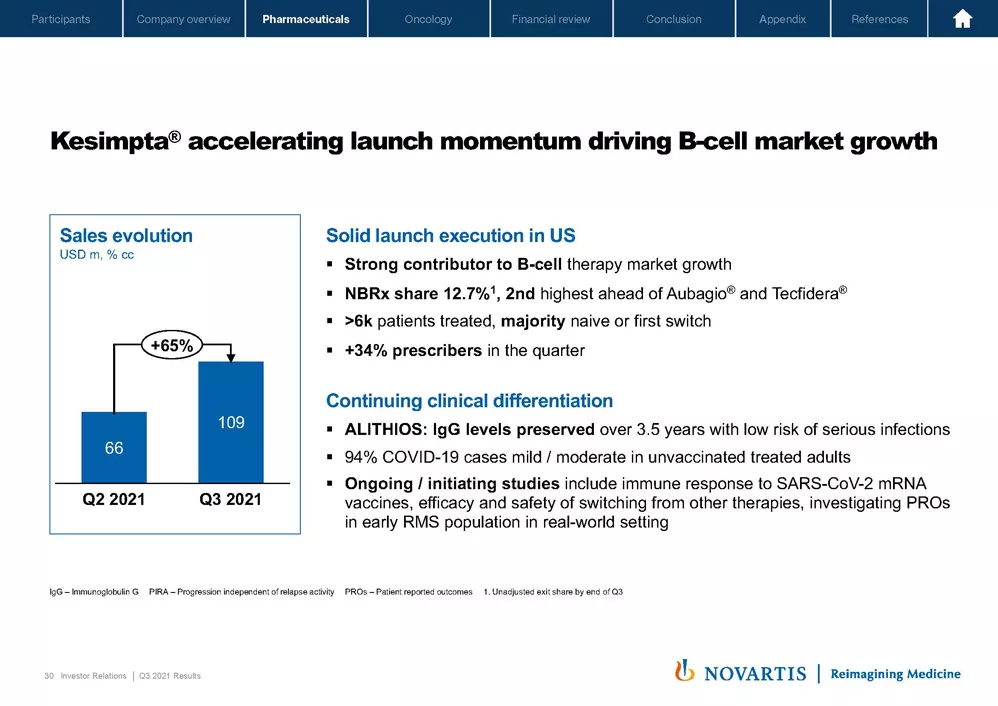
If I move on to Slide 30, while the multiple sclerosis market has contracted quarter-over-quarter, Kesimpta® grew 65% (edited). Importantly, Kesimpta® has been a strong driver of the dynamic B-cell market with an additional 1,000 patients on treatment.
Our strategy remains focused on 3 elements: Increasing familiarity, we're maintaining a high share of voice, and we've added more than 500 prescribers versus Q2; driving further clinical differentiation, we just presented 3.5 years of IgG data at ECTRIMS, and we're generating evidence on switching and patient-reported outcomes needed to change clinical practice; we're also focusing on customer experience, ensuring fast onboarding and broad access to make it easy to initiate patients.
We continue to see more than 50% of our uptake in first line / first switch, and we know how important this is because this is where we can have the highest impact on progression and long-term outcomes. We see huge potential in this B-cell market, and we're driving the growth in the dynamic segment. We have the right strategy, and we're going to take further share as the market rebounds.
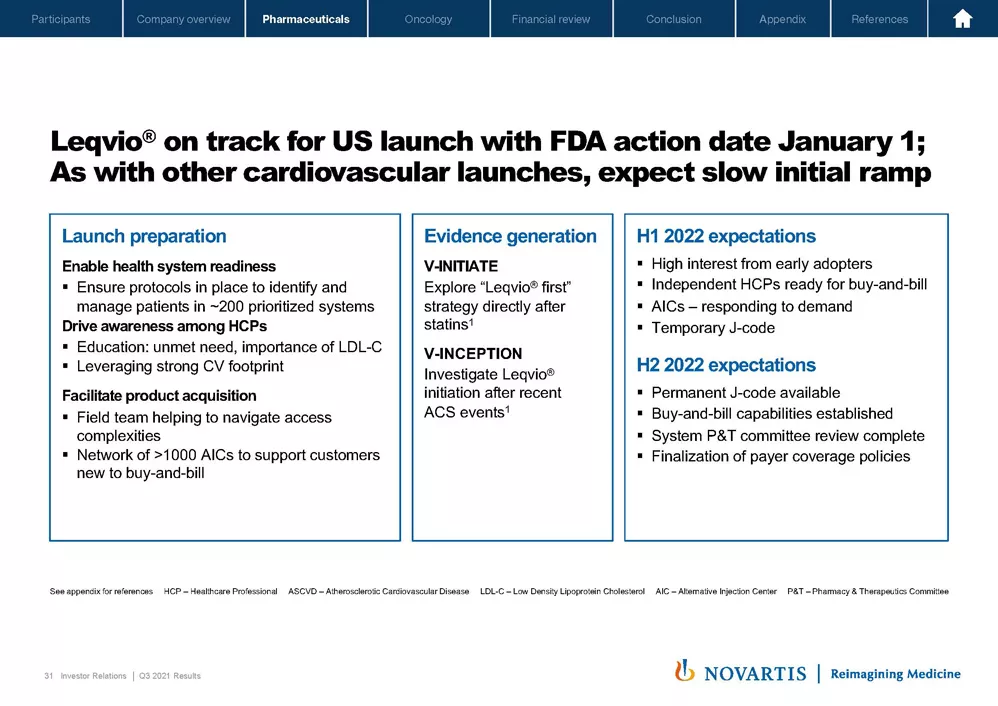
Moving on to Slide 31. On Leqvio®, you most certainly saw that we received NICE approval, and we're currently working to implement our broad reaching commercial agreement with NHS England. We have also been fully focused on the upcoming US launch. We're working closely with health care systems to prioritize ASCVD to identify patients to set up buy-and-bill. And we're also leveraging our Entresto® sales force to educate on the unmet need in ASCVD. For customers who may not want buy-and-bill, we're creating a network of alternative injection centers where patients can receive Leqvio®. We've signed up more than 1,000 centers and expect them to become a significant factor in pulling through our demand early on.
We're also ensuring we generate the right evidence needed to succeed in the US market. Based on our engagement, we expect the majority of the 200 prioritized health care systems to start treating patients in 2022. The uptake will be skewed to the second half of the year when the majority of the system should be ready for buy-and-bill and our permanent J code should be issued. We're working with diligence. We're taking a long-term perspective on what needs to be done to transform how ASCVD is treated to make Leqvio® one of the biggest medicines for Novartis.
In summary, we continue to execute against our strategy, maximize our growth drivers, deliver our launches and prepare for the next wave of products.
The teams are working with a strong sense of urgency and purpose to be more customer focused, so we can bring our innovation to more patients faster.
I want to thank the teams around the world for their commitment and show my confidence in the continued momentum for a strong year-end. Now let me hand it over to Susanne.
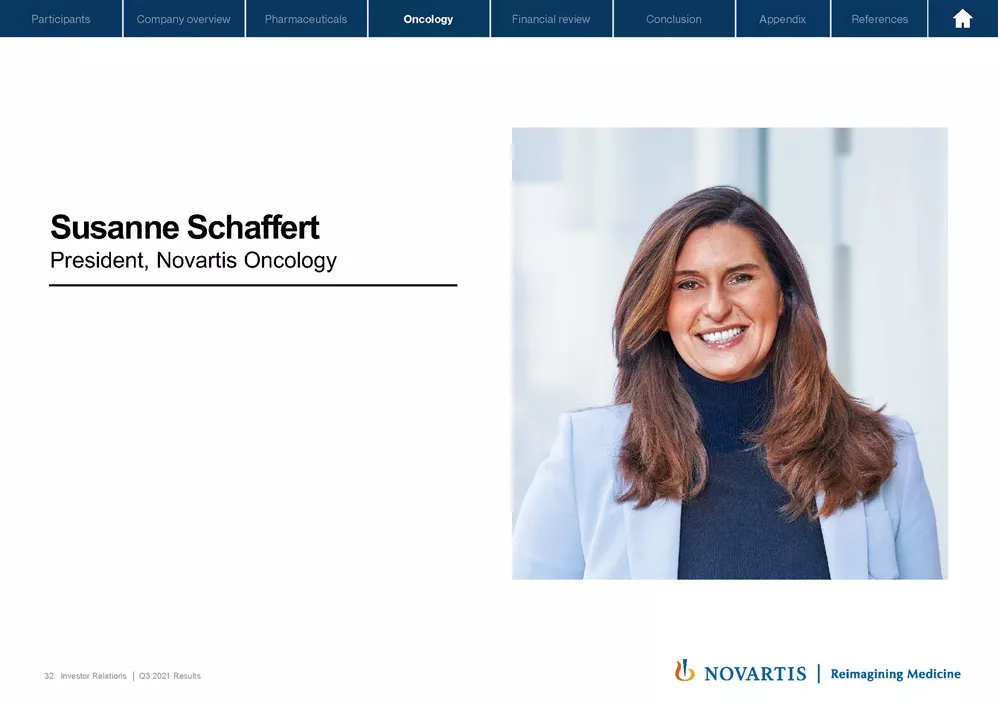
Thank you, Marie-France.
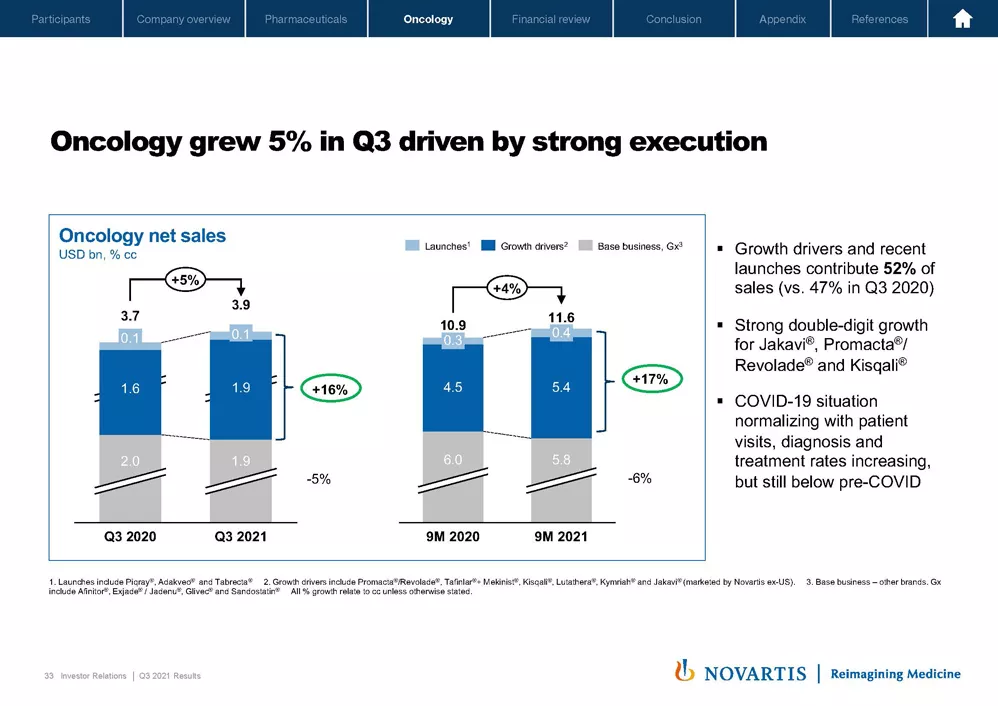
Moving to Slide 33. The Oncology business delivered a solid quarter, growing 5% versus prior year with sales of USD 3.9 billion. Our growth drivers as well as recent launches performed well with 16% growth versus previous year, driven by Jakavi®, Promacta®/Revolade® and Kisqali®. Together, these products now contribute to more than half of the overall Oncology sales.
In the third quarter, we have seen health care systems in oncology slowly returning back to normal as patient visit, diagnosis and treatment rates are gradually improving. We are seeing that new patient starts continue to accumulate and expect this to translate into growth acceleration in segments like recent launches and hospital administered products by the end of the year.
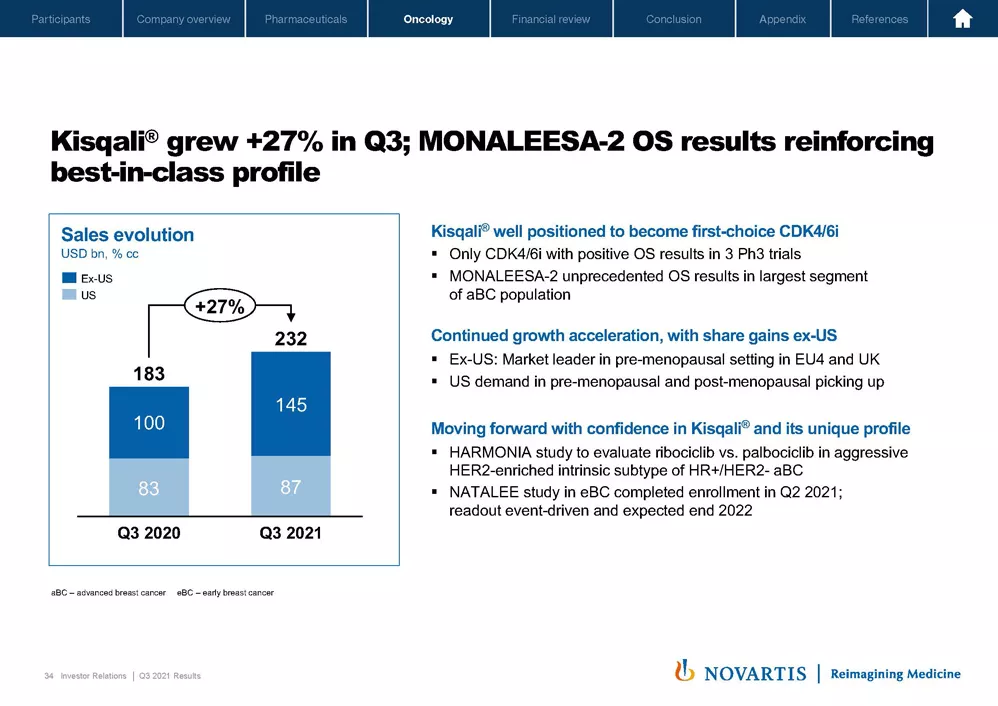
Moving to Slide 34. Kisqali® delivered strong performance in the third quarter, growing 27% with sales of USD 230 million. The uptake was mainly driven by continued very strong momentum and patient share gains ex US, particularly in Europe. We achieved market-leading position with 40% patient share in premenopausal patients in the EU4 and UK. It is a doubling in patient share since we reported overall survival results from MONALEESA-7.
In the US, Kisqali® grew 5% versus previous year, driven by increased demand in pre- and post-menopausal patients, with usage shifting to earlier lines of therapy, which is very encouraging. And as you heard from Vas, we are very excited about the new OS data for MONALEESA-2 that showed the longest overall survival ever reported in advanced breast cancer, achieving a median overall survival of over 5 years.
We believe that such impressive results are the evidence of Kisqali®'s ability to change tumor biology to enable a better response to endocrine-based therapy. Kisqali® is now the only CDK4/6 inhibitor with proven OS benefit across all 3 Phase III trials of the MONALEESA program with different endocrine therapy partners regardless of menopausal status or line of therapy.
Therefore, with a lot of confidence in Kisqali®, we have started a collaboration with SOLTI and initiated a Phase III trial called HARMONIA to evaluate ribociclib versus palbociclib in patients with aggressive HER2-enriched intrinsic subtype of HR-positive HER2 advanced breast cancer.
As Vas said, we are also very excited about the adjuvant NATALEE study that is exploring Kisqali® in both intermediate and high-risk population. And this would have the potential to more than triple patients of the metastatic setting. NATALEE study completed enrollment ahead of schedule in second quarter of this year, and we are looking forward to a readout in 2022.
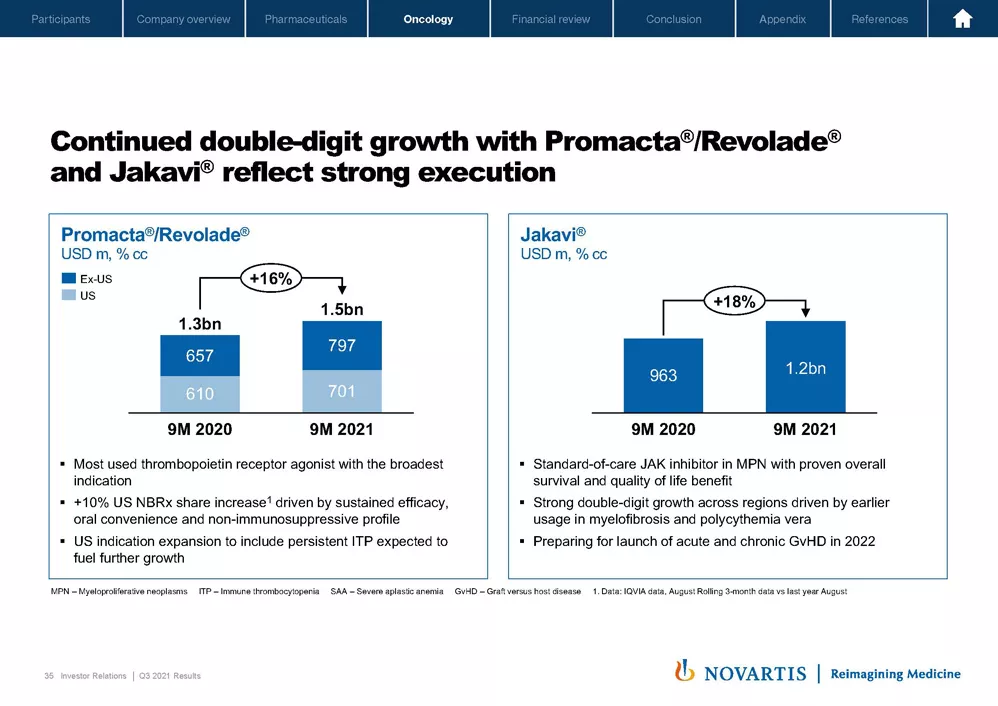
Moving to the next slide. I am pleased to share with you that our 2 blockbusters in the hematology franchise, Promacta®/Revolade® and Jakavi® continue to deliver very strong double-digit performance, driven by strong demand across all regions. Promacta®/Revolade® is our thrombopoietin receptor agonist indicated for use in ITP and severe aplastic anemia.
The brand continued to perform very strongly, driven by sustained efficacy, oral convenience and non-immunosuppressive profile. In the US alone, we have seen 10% increase in new patient starts versus previous year and expecting that further uptake will be fueled with the expansion of the US indication to include persistent ITP.
Ex US, Revolade® is also performing strongly, driven by increased use in both indications and also additional demand from China. Jakavi® is our JAK inhibitor and the standard of care in myelofibrosis and polycythemia vera and has also demonstrated impressive growth with significant uptake coming from earlier use in both indications and strong momentum in China. We have completed filings in acute and chronic graft versus host disease in the EU and are actively preparing for launches in 2022. So overall, I'm very pleased with the performance of these 2 important hematological brands and the potential they have in terms of future growth and patient benefit.
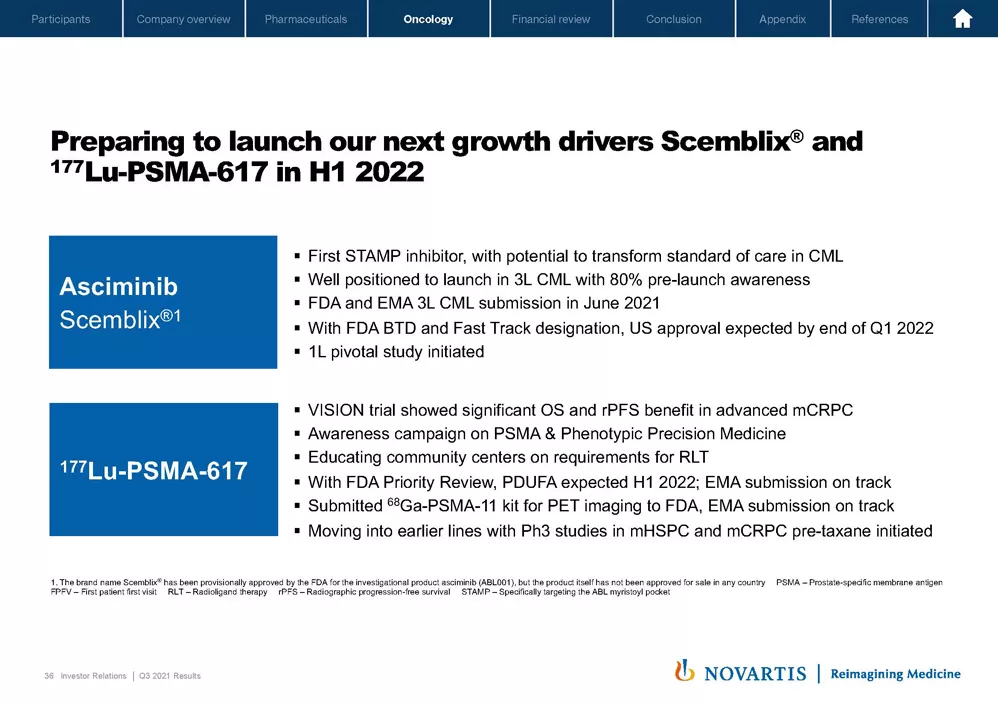
Moving to Slide 36. I would like to update you on how we are preparing for the upcoming launches of asciminib and Lu-PSMA-617. Asciminib is our STAMP inhibitor that has the potential to transform the standard of care in CML. In the Phase III ASCEMBL study, asciminib nearly doubled the major molecular response rate at 24 weeks compared to bosutinib. Asciminib is well positioned for launch in third-line CML as we are preparing to leverage our broad commercial footprint and the established collaboration with the hematology community.
We are pleased to see a very high prelaunch awareness of 80% amongst hematologists. We have completed FDA and EMA filing earlier in June. The US FDA has granted 2 breakthrough therapy designations and Fast Track designation for asciminib and is reviewing the file under real-term oncology review with approval expected early next year.
And just to remind you that asciminib has blockbuster potential in the third line. But we are also seeing opportunity to address the unmet need in first-line CML, and therefore, have initiated a Phase III study of asciminib versus investigator-selected TKIs with final readout expected in 2024.
Another exciting asset that we are preparing to launch is our radioligand therapy, lutetium-PSMA-617 that has demonstrated significant OS and rPFS benefit in advanced metastatic prostate cancer. Our awareness campaign on PSMA and Phenotypic Precision Medicine is progressing well with the awareness among target physicians doubling over the last 12 months. Our focus is on the top 200 treatment centers and education about process optimization as well as on treatment site expansion to ensure site readiness at launch.
We completed filing with FDA. And in addition to breakthrough therapy designation, also received priority review with PDUFA date in the first half of 2022. In addition, we have completed filing to FDA for registration of our own gallium-PSMA-11 PET kit to further support availability of imaging agents. And submission of both lutetium-PSMA and gallium-PSMA PET to the EMA is on track. So we are moving with confidence into earlier lines of therapy and have initiated 2 Phase III studies with lutetium-PSMA in metastatic hormone-sensitive prostate cancer and in pre-taxane metastatic prostate cancer. So overall, very much looking forward to bringing these 2 assets to market. And with that, I hand over to Harry.
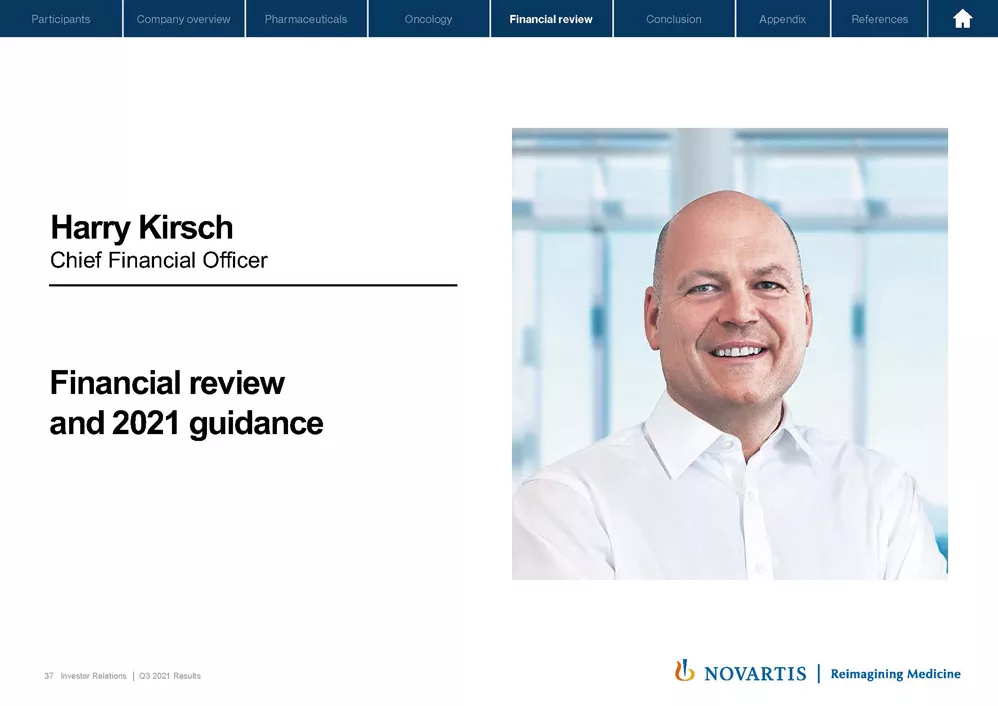
Yes. Thank you, Susanne. Good morning and good afternoon, everyone. I'm now going to walk you through some of the financials for the third quarter and the first 9 months of the year. And as always, my comments refer to growth rates in constant currencies, unless otherwise noted.
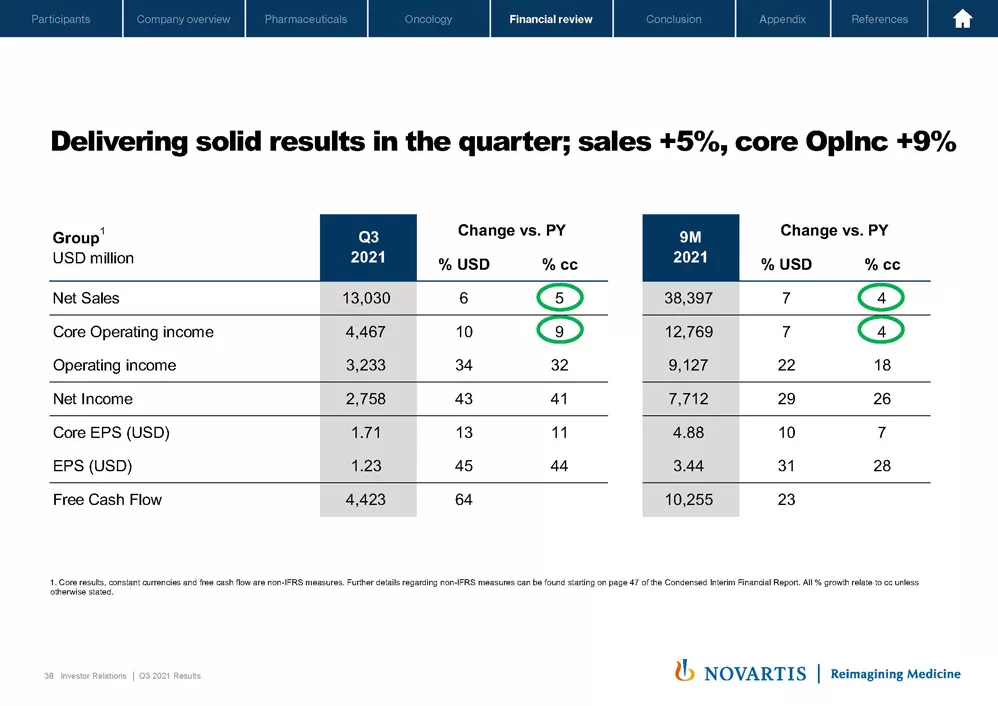
So on Slide 38, we see the summary of our operational performance for the third quarter and the first 9 months, very solid quarter 3 with strong performance of our Innovative Medicines division. As we had anticipated, the business is normalizing post COVID-19 with Group sales up 5% and core operating income growth of 9%. Quarter 3 net sales reached USD 13 billion, driven by the Innovative Medicines growth drivers.
Core operating income of USD 4.5 billion was driven by higher sales and productivity programs across the business. Core EPS was up 11% to USD 1.71, and free cash flow grew very strongly by plus 64% in US dollars to USD 4.4 billion.
Year-to-date performance reflects the slower growth in the first half of the year, mainly due to the impact of COVID in certain parts of our business. We grew top and bottom line 4%, and core EPS grew 7% to USD 4.88. And free cash flow was USD 10.3 billion, growing 23% in US dollars.
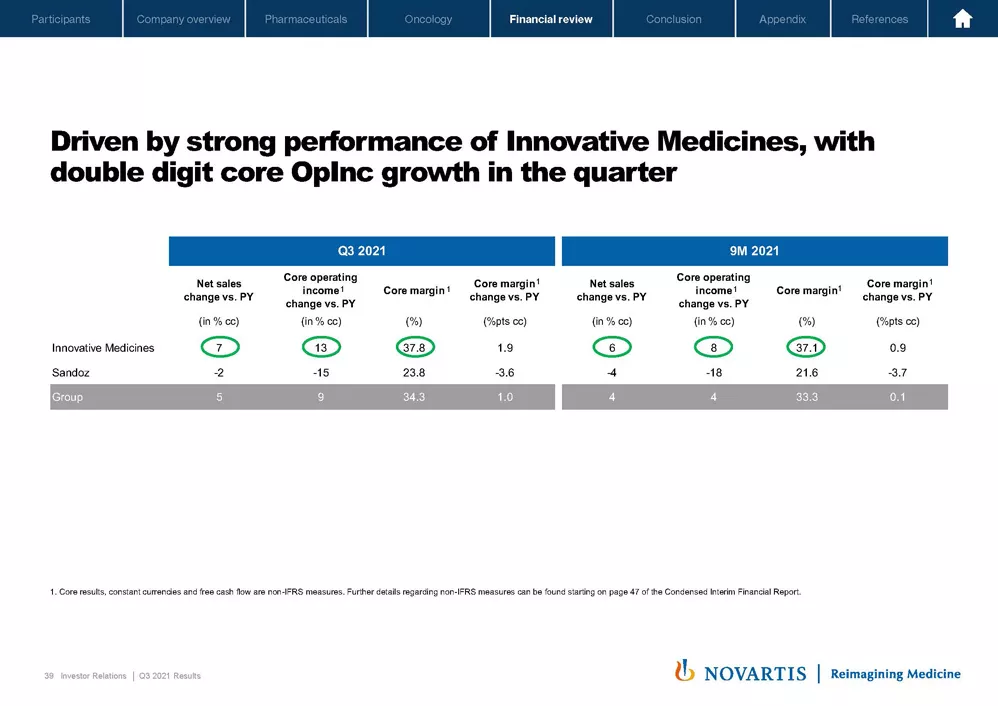
Next slide, please. On Slide 39, I want to break down our performance by division. And as mentioned, the solid performance of the company was driven by Innovative Medicines, which delivered a strong quarter with 7% top line growth, 13% bottom line growth and a margin of almost 38%. Looking to the first 9 months for the year, Innovative Medicines showed a healthy growth of 6% on top line and 8% on the bottom line with margins of 37%. I'd just like to remind you of the seasonality of margins. As you know, the fourth quarter has usually the lowest margin due to higher spending phasing.
Innovative Medicines' year-to-date performance was driven by continued strong double-digit growth of the key brands, Vas and Marie-France and Susanne mentioned, with USD 3.5 billion sales, growing 18% for Cosentyx®, Entresto® with USD 2.6 billion, growing 41%. Zolgensma® reached already USD 1 billion in sales. The Kesimpta® launch was accelerating. Additionally, the Onco key growth drivers continue to do very well.
Moving to Sandoz. Nine months performance reflects a heavier impact from COVID than in the other parts of the business. However, in quarter 3, Sandoz has seen some recovery, particularly ex US, where sales grew 3%, driven by both Biopharmaceuticals and Retail Generics. US sales were impacted by double-digit price erosion, partnership terminations as well as higher off-contract sales in the prior year.
The US continues to be a challenging business environment for the wider generics market. However, we expect the situation to improve also in the US in the midterm as the impact of COVID-19 lessens and our biosimilar launches begin to deliver.
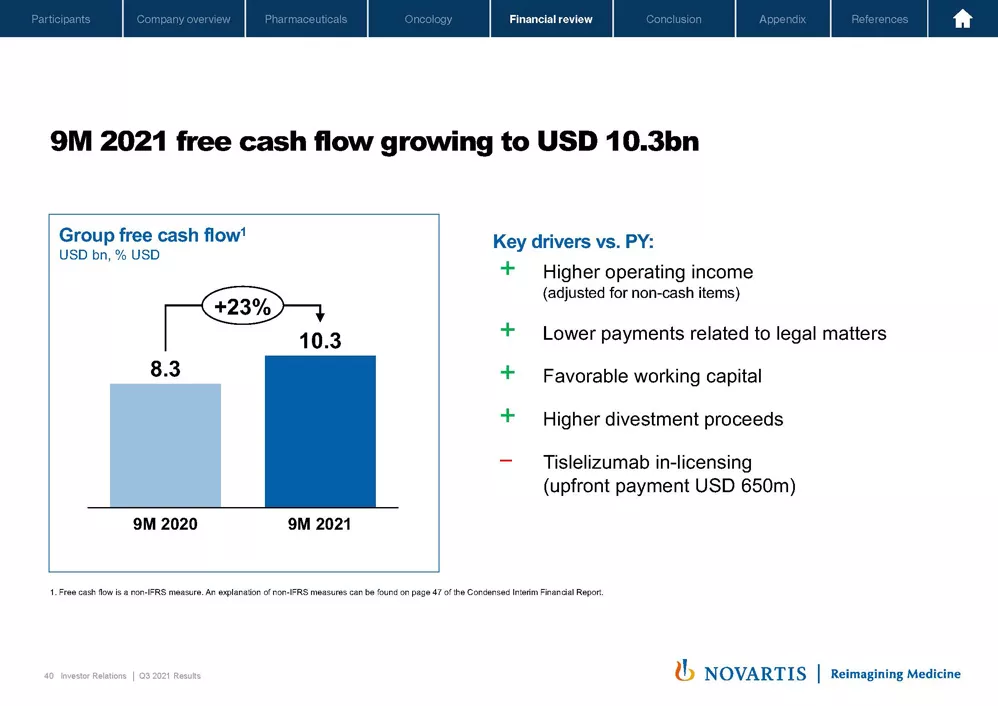
On Slide 40, I just want to highlight the impressive growth we have seen in free cash flow, which is now USD 10.3 billion for the first 9 months, up 23% compared to the prior year. The main drivers of this have been higher operating income, lower payment from legal matters compared to what we had last year and favorable working capital.
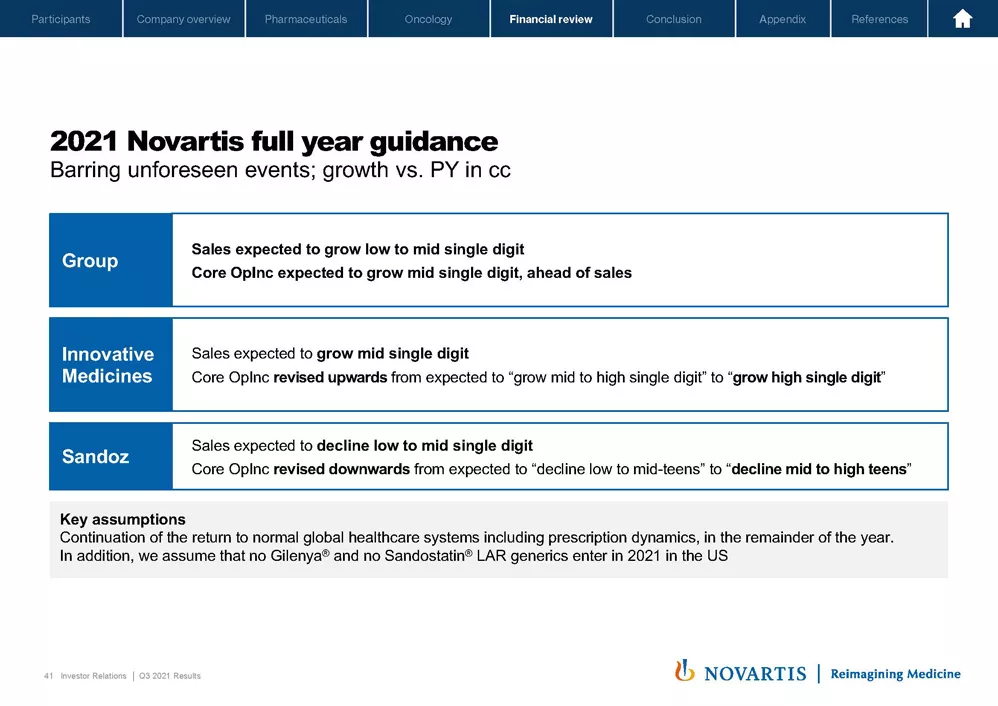
Now turning to our full year guidance on Slide 41. Overall, for the Group, we confirm the current guidance. For sales, we continue to expect low to mid-single-digit growth. And for the bottom line, we expect mid-single-digit growth ahead of sales. For Innovative Medicines and Sandoz, we are confirming the top line guidance, but we are fine-tuning our bottom line guidance. We continue to expect Innovative Medicines division sales to grow mid-single digits.
Reflecting the strong performance of the division, we have revised upwards core operating income guidance, which we now expect to grow high single digit. For Sandoz, we continue to expect sales to decline in the low to mid-single-digit range, but we now expect core operating income to decline mid- to high teens. The key assumption for the guidance is that we see a continuation of the return to normal global health care systems and prescription dynamics in the remainder of the year. And in addition, we continue to assume that no Gilenya® and no Sandostatin® LAR generics enter the US market in 2021.
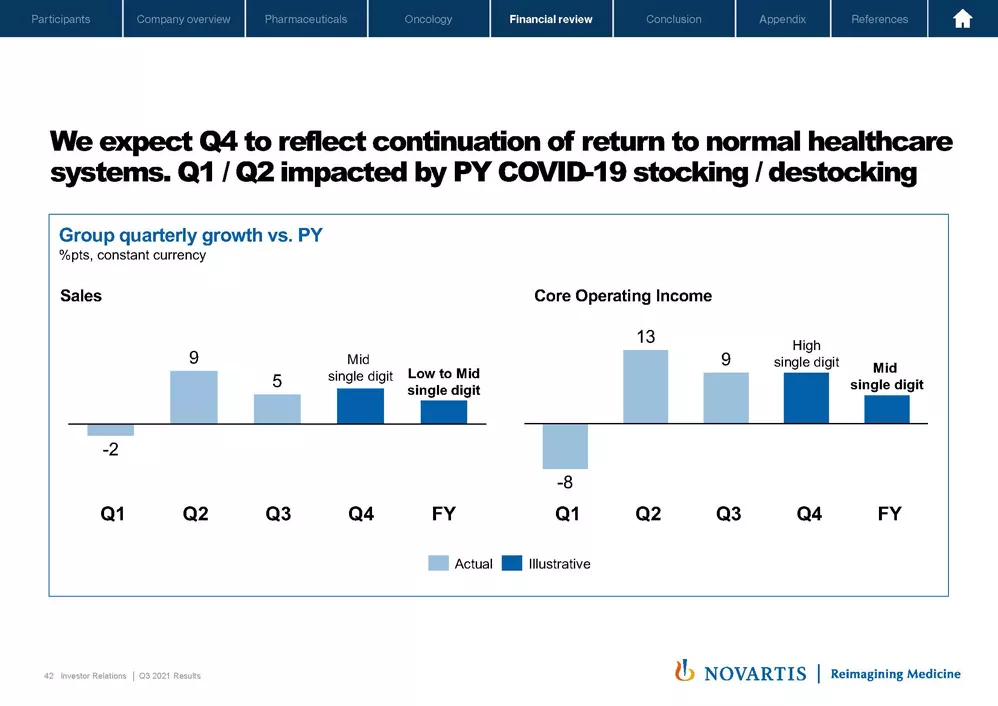
Next slide, please. We thought it might be helpful to you to outline our expectations for the fourth quarter. In short, we expect a similar growth in quarter 4 as we had it in quarter 3, with the top line growing in the mid-single-digit range and bottom line growing high single digits. Taking into account our year-to-date 4% growth both for top and bottom line, this brings us to our full year guidance of low to mid-single-digit growth for sales and mid-single-digit growth for the core operating income line.
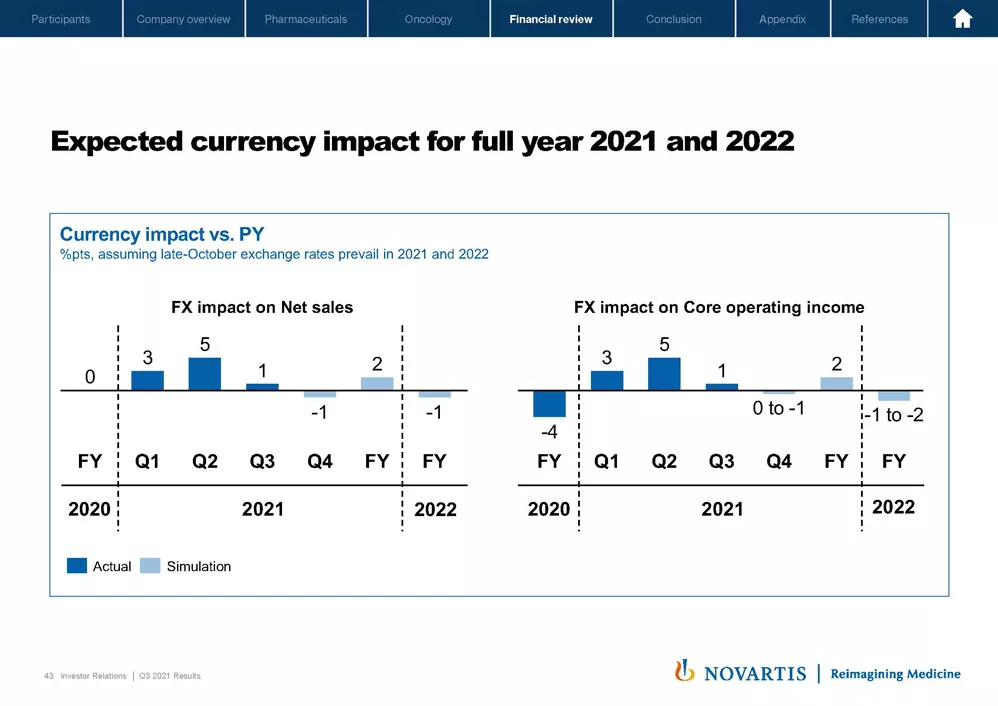
Finally, on Slide 43. As currencies are constantly changing, I want to bring to your attention the estimated impact currencies would have on our results using the current exchange rates. So if late October rates prevail for the remainder of 2021, the full year impact of currencies would be a positive 2 points on both sales and core operating income. For quarter 4, it would be negative 1% point on sales and between 0% and negative 1% point on core operating income. And as a reminder, we always update these impacts of the currencies on our website on a monthly basis. And with that, I hand it over back to Vas.
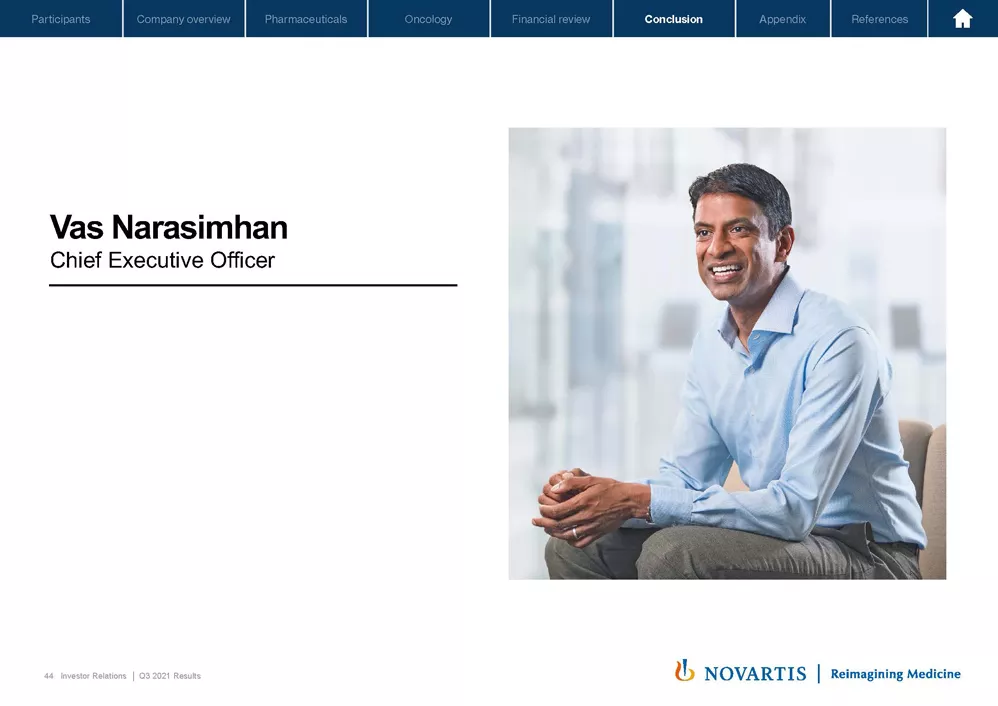
Thank you, Harry.

So moving to Slide 45. We did want to give you an update on some of the events we'll be holding later this year and into next year. Based on feedback from our investors, we've decided to convert our December 2 event, our Capital Markets Day, to a focused R&D event on Innovative Medicines. Here, we'll go over our R&D assets, life-cycle management programs, our mid-stage portfolio in each of our key therapeutic areas as well as have our NIBR scientists on hand to discuss our technology platforms and other efforts within NIBR. And on May 23 and 24 of 2022, we'll plan for a Meet Novartis Management event, which we hope to hold in person.
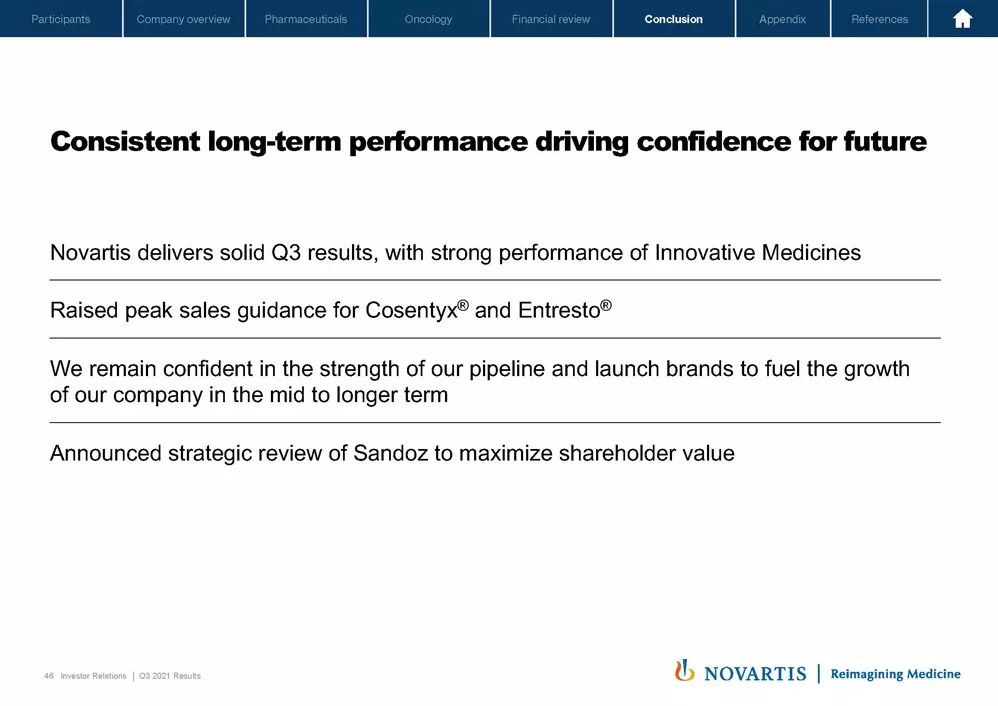
So moving to Slide 46. In closing, a solid quarter, strong performance from Innovative Medicines. We braced our peak sales guidance, really demonstrating our confidence in the long-term growth of the company. We remain confident in the pipeline, in the launch brands to fuel our growth not only in the midterm, but also with our science-based innovation for the longer term. And we've announced a strategic review of Sandoz, a leading business in generics, operating in an attractive market, that this is the right moment to really evaluate who is the best owner for that business for the long term.
So thank you very much for listening, and we'll open the line up for questions. I would say to each of our questioners if you could limit yourself to one question and then move back into the queue we can do our best to accommodate everyone’s question. So with that, operator, please open the line. (Operator Instructions)
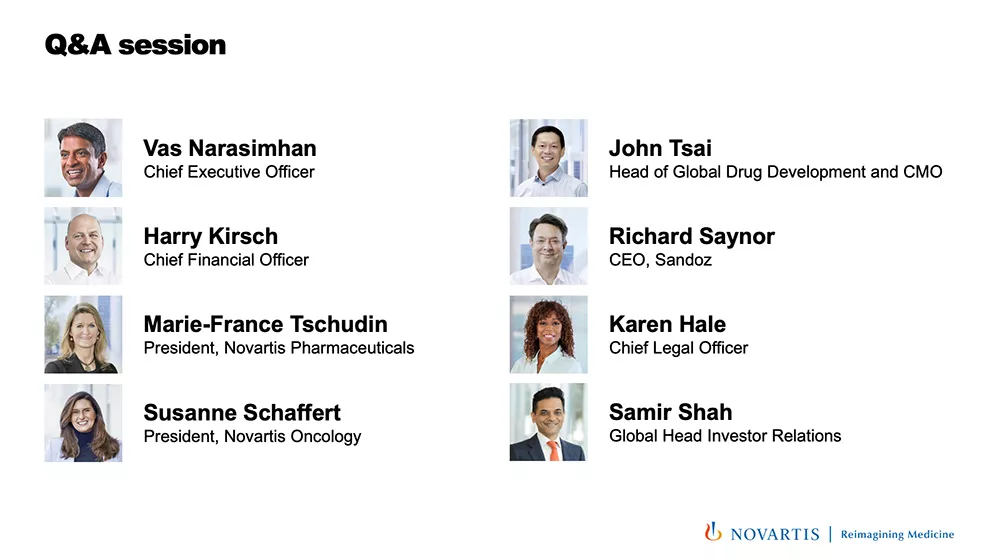
• Operator
Your first question comes from the line of Graham Parry from Bank of America.
• Graham Glyn Charles Parry - BofA Securities, Research Division
Q. So it's on NATALEE and your comments on the slide that you've rereviewed the FDA feedback and that invasive disease-free survival is acceptable as a primary endpoint provided no detriment to overall survival. And that seems contrary to how it's treated Lilly's Verzenio®, where they were asking for more OS data to see if the curves are separating. So can you just clarify when was that feedback given? And why do you think FDA could treat Kisqali® differently from Verzenio®? And are you stratifying by Ki-67 score as well given the FDA was also interested in or only approved in that biomarker population for Verzenio®?
• Vasant Narasimhan – CEO of Novartis
A. Thanks, Graham. John?
• John Tsai – Head of Global Drug Development and Chief Medical Officer for Novartis
A. Yes. Thanks for the question, Graham. And we did have discussions with the FDA on our NATALEE trial. As you know, we increased the sample size for our NATALEE trial, knowing the criteria that we've included for the overall study population.
These discussions were recent. I would say that it was within the end of the third quarter where we had these discussions, and they gave us very clear feedback that the design and the endpoints actually would be supported based on the invasive DFS endpoint given that, obviously, the results would be based upon the overall totality of the evidence that's available.
As Vas disclosed earlier and shared with you, we have looked at the overall patient population. We've looked at the overall population focused on intermediate and high-risk patients in this study, which is based on the AJCC criteria. That also includes biomarkers and gene expression tests to select the high-risk patient population overall. So what we also know is based on the intermediate risk population, the IDFS rates are similar in this intermediate risk population as in the high-risk population. So based on the overall totality of the background here, we're very confident in our approach.
• Vasant Narasimhan – CEO of Novartis
A. Maybe just wanted to – I think you asked specifically. We do collect Ki-67 data in the study. But right now, that's not part of our statistical analysis plan. And of course, we'll share that data with the FDA when requested. Thanks, Graham. Next question.
• Operator
A. Your next question comes from the line of Peter Welford from Jefferies.
• Peter James Welford - Jefferies LLC, Research Division
Q. Just on the Sandoz strategic review, I wonder if you can give us some insights into perhaps what internally there are metrics that you're perhaps assessing or looking at during the course of next year. And also whether or not there's still the aim to both, I guess, return this business to growth, but also still potentially put the margins back on a positive trajectory before the business is separated? Or if you now believe that the US oral solids business is now essentially in terminal decline, and that business is not a business that you feel is appropriate to be part of Novartis?
• Vasant Narasimhan – CEO of Novartis
A. Thanks, Peter. So I think as always, and as we learned through our Alcon review as well, we consider a number of factors. One, of course, is the synergies between our Innovative Medicines business and the Sandoz business as well as the dissynergies between holding both of these businesses. We also consider, I think, capital allocation and capital allocation measures to ensure we're optimally allocating capital to maximize shareholder returns.
We, of course, want to consider what would enable us to build the best generics company at the aspiration to be a leading generics company in the world and which setup would best enable that. So I mean those are all in broad strokes, the factors. And I think you saw with the Alcon spin that we're adaptive at understanding these factors, hopefully, making the best decision for our shareholders and the relevant businesses and then taking the relevant actions. Harry, anything you want to add?
• Harry Kirsch – CFO of Novartis
A. I think, Peter, of course, all of the other details, right, the different options have different tax implications. If it would not be retaining the business, all of those, you would expect that we would, of course, always consider. But I think all of this will be part of our strategic review. And I think fundamentally, the question comes down to who's the best owner of this very good generic business.
• Vasant Narasimhan – CEO of Novartis
A. Maybe Richard, on the growth profile. Richard?
• Richard Saynor – CEO of Sandoz
A. Yes. Thank you, Vas. I mean, Peter, you commented about the US. I mean clearly, the US business, we've just had very few launches in terms of oral solids over the last year, 18 months. And clearly, we're watching out a number of the partnership deals as well.
The medium, long term looks much more attractive, both as we accelerate the number of small molecule launches. But also more importantly, we bring a number of biosimilars to the marketplace over the next 3, 4 years, which should materially change the direction of the business, both in the US. It's also worth noting that the European business now is back into growth as is our international business. So broadly, it's starting to normalize post-COVID.
• Vasant Narasimhan – CEO of Novartis
A. Thanks, Richard. Thanks, Peter, for the question. Next question, operator.
• Operator
A. Your next question comes from the line of Andrew Baum from Citi.
• Andrew Simon Baum - Citigroup Inc., Research Division
Q. Question for John, relates to canakinumab. John, if I remember in CANTOS, the early separation of the curve, the treatment effect that we saw with canakinumab was attributed to occult metastatic disease in these patients. With that in mind, assuming it is a viable mechanism, should we expect an interim analysis to read out positively? And if it doesn't, we should, therefore, assume the probability of success is very low.
And then separately, perhaps you could comment on whether even there's any role for this drug given this is an increasingly well-served indication, meaning the adjuvants with Tecentriq®, Tagrisso®, and more indications – more drugs on the way.
• Vasant Narasimhan – CEO of Novartis
A. Yes. Andrew, I'll take it, obviously, because I was one year with the CANTOS study when I was development head. So in that result, I think, first and foremost, it's important to note that the CANTOS study had an inclusion criteria of 2 milligrams per L (edited) of hsCRP. The median was in that kind of 2 to 5 range in the overall study population.
Our hypothesis at the time was that these were undetected cancers, cancers that were not detected in the screening, either through physical diagnosis or imaging that in the course of the study, canakinumab was able to reduce the incidence of these cancers becoming fulminant and the mortality of these patients. This, we believed, was due to IL-1 beta's role in the tumor microenvironment and IL-1 beta potentially having a role in enabling and blocking IL-1 beta, enabling immune cells to enter the cancer and therefore, potential synergistic effect in the metastatic setting. And in the adjuvant setting, that in the initial stages of a tumor's development, that IL-1 beta plays an important role.
So I don't think that an interim read on this is going to be meaningful. I think the study was going to have to go to the end. We believe the positioning of the medicine is very much that canakinumab, in our view, has a very favorable safety profile given the long experience we have treating children with this medicine who find it very well tolerated. We didn't see any differences in this first-line setting.
And so having the potential, and I would say it's high risk, to be clear, of an all-comers therapy for the adjuvant setting that does not require any PD-1 screening could be attractive. Now whether physicians choose an IL-1 beta therapy or a PD-1 inhibitor, that will all have to be figured out. But it's important to note as well the adjuvant CANOPY-A study is an all-comers study based on what we knew at the time from the CANTOS study and is the lowest CRP group of these studies in terms of the median CRP levels and the enrolled patients, most consistent with the CANTOS study. Thank you, Andrew. Next question, operator.
• Operator
A. Your next question comes from the line of Laura Sutcliffe from UBS.
• Laura Sutcliffe - UBS Investment Bank, Research Division
Q. Just on your new Entresto® peak sales guidance, does that USD 5 billion number capture the possibility of an LOE earlier than the 2025 anchor date that we've been talking about so far?
• Vasant Narasimhan – CEO of Novartis
A. Marie-France?
• Marie-France Tschudin – President, Novartis Pharmaceuticals
A. Yes. So for our internal forecasting assumptions, we're looking at 2025, and that's how we've forecasted. So if you'd like a little bit more detail on why we feel comfortable with the USD 5 billion plus on Entresto®, it's really based on the significant market potential, the further implementation of guidelines and obviously, the recent launches in Asia. And that leads us to a USD 5 billion plus mark, but that is assuming, for internal guidance, a 2025 LOE.
• Vasant Narasimhan – CEO of Novartis
A. Thanks, Marie-France. Next question, operator.
• Operator
A. Your next question comes from the line of Simon Baker from Redburn.
• Simon P. Baker - Redburn (Europe) Limited, Research Division
Q. Question for Susanne on Lu-PSMA. I was wondering if you are pursuing on the diagnostics side, a technetium-PSMA imaging kit. Because the feedback that we've had from radiologists over here is that there is a huge excitement in the UK about Lu-PSMA. But there is some concern that its utility beyond large centers because of the need for gallium-PSMA screening will make it harder to use more broadly. I was just wondering if that's feedback you've seen elsewhere, if you're looking at using the much more easy-to-administer, if not quite so impressive technetium-PSMA kit in order to broaden the number of centers that can practically use it.
• Susanne Schaffert – President, Novartis Oncology
A. So thank you, Simon, for the question. So we have focused on gallium-PSMA really to have this ready for launch. And we wanted to make sure that there is a diagnostic available. You see the other options also focus on gallium. And then I think there is quite a push for fluoride-PSMA diagnostic as this is still, I would say, across the G7 markets, the most used diagnostic.
I think technetium is quite focused in the UK. I didn't hear so much about that ex UK. And I mean, as we are targeting earlier lines of therapy, you have to see that we really have a diagnostic available that is very easily available and that's certainly the fluoride one. So that's what we are focusing on. And probably technetium is quite focused in the UK.
• Vasant Narasimhan – CEO of Novartis
A. Thanks, Susanne. And I just wanted to take a step back. I have to clarify a comment I made to Graham's question. For NATALEE, we are collecting Ki-67. It's in about 70% to 80% of the total enrolled patients. It's part of the statistical analysis plan, but not a prespecified stratification factor. So with that, we'll move to the next question.
• Operator
A. Your next question comes from the line of Keyur Parekh from Goldman Sachs.
• Keyur Parekh - Goldman Sachs Group, Inc., Research Division
Q. One on Leqvio® please. Marie-France, kind of you spoke about the confidence in Leqvio® launch and the preparedness for that going into 2022. Kind of the clarity around what you partnered with NHS in England still remains very kind of dim or very unclear. So just wondering if you can give us a bit more details on how we should think about the rollout of this molecule in the UK.
And then just in the same vein, I think consensus is looking at about USD 250 million in revenue for this drug next year. Do you think that appropriately reflects what you see as the launch dynamics for this? Or should we be thinking about something lower or higher than USD 250 million for Leqvio® next year?
• Vasant Narasimhan – CEO of Novartis
A. Marie-France?
• Marie-France Tschudin – President, Novartis Pharmaceuticals
A. All right. So thanks for the question and the opportunity to talk about Leqvio®. So on the UK, first of all, we're very happy with the positive NICE approval and the commitment from the NHS to fund and treat 300,000 ASCVD patients. I think this provides solid proof that we can get the broad access prior to the outcomes data and based on the back of, obviously, solid evidence around LDL-C lowering.
So what we're doing right now in the UK, and this is going to be the focus for the next couple of months, is really identify patients and work on the care pathways to reach 1,200 GP networks. It's early days, but we're doing – we're having – we're seeing really great progress around central funding, the digital patient IDs, the incentives for GPs and the educational programs. And the feedback from lipid specialists and GPs has also been very positive. So we expect a slow ramp in Q4. But you can expect to see some significant ramp-up in Q1 of next year for the UK.
If I then turn to the US. Again, here, we're focusing on the 200 systems of care. And as we said, we're also looking to build buy-and-bill. The first half of the year is going to be focused on our J code, building up the buy-and-bill infrastructure, going through the P&T reviews and making sure that we're ready. And then you'll see that uptick towards the second half of the year. And the number you quoted, we feel extremely comfortable with that number for next year.
• Vasant Narasimhan – CEO of Novartis
A. Thanks, Marie-France. Next question, operator.
• Operator
A. Your next question comes from the line of Seamus Fernandez from Guggenheim Securities.
• Seamus Christopher Fernandez - Guggenheim Securities, LLC, Research Division
Q. Just a quick question. I noticed that your G12C agent moved into or is planned to move into Phase III. Can you just help us understand the data that prompted the planned advancement of the KRAS G12C inhibitor?
And then just as a follow-on to that, do you think this asset can differentiate meaningfully from other therapies on its own? Or is the differentiation really key to near-term development in combination with your SHP2 inhibitor.
• Vasant Narasimhan – CEO of Novartis
A. Thanks, Seamus. I'll hand that to John. John?
• John Tsai – Head of Global Drug Development and Chief Medical Officer for Novartis
A. Seamus, thanks for the question. And our KRAS G12C, which is JDQ433 in our program, we've advanced this molecule forward and plan to have Phase III in place by the first half of next year. What we've seen is really good PK/PD data and good tolerability by the patients. As we move forward, you'll be hearing more about this in the congresses next year.
On your specific question about the strategy moving forward and differentiation versus the other KRAS G12Cs and potential marketplace and in the marketplace now, we think that the approach for KRAS G12C is really in combinations. What we've seen so far is that you are getting – the durability is probably not as long as what we would like and that we're seeing mutations. And with those mutations, it will be a combination approach. And these combinations could be a number of factors, including our potential TNO SHP2 in our pipeline. You'll be hearing about that combination from our pipeline next year also.
• Vasant Narasimhan – CEO of Novartis
A. Thanks, John.
• Operator
A. Your next question comes from the line of Sarita Kapila from Morgan Stanley.
• Sarita Kapila - Morgan Stanley, Research Division
Q. So if you could help us understand the rationale for taking your BTK inhibitor remibrutinib forward in CSU, especially when ligelizumab is being trialed in this setting also? And how are you thinking about positioning of the 2 assets relative to one another and also to Dupixent®?
• Vasant Narasimhan – CEO of Novartis
A. Thank you for the question. John?
• John Tsai – Head of Global Drug Development and Chief Medical Officer for Novartis
A. Yes. So remibrutinib, as you probably have seen, is highly our selective and potent covalent oral BTK inhibitor. We did do an extensive Phase II program in CSU, which was recently released. And what we saw is really good uptake, and the efficacy was extremely strong.
Now what we've seen is the efficacy was seen both at 4 weeks and at 12 weeks. And in addition to that, we saw efficacy very early at the 1-week time point. So really strong efficacy data, pin back on the safety profile, which as we think about BTK inhibitors, sometimes are saddled with LFTs, also cytopenias, and we did not see that in our overall program. So given our approach, we're very comfortable advancing CSU into our Phase III program.
Now one thing we should also note is ligelizumab, we've seen Phase II results, which were equally strong. And the approach that we're taking here is ligelizumab would be giving patients an opportunity acute 4 week treatment with a subcu injection. And then remibrutinib would be an oral opportunity given the large, massive unmet need in CSU patient population. That's our overall approach.
• Vasant Narasimhan – CEO of Novartis
A. And I think Marie-France could add a few more points. Marie-France?
• Marie-France Tschudin – President, Novartis Pharmaceuticals
A. Yes. So just maybe going back to the size of the market and the unmet need. So we know there are about 1.3 million CSU patients who are inadequately controlled in the top 11 markets. In fact, these patients are on antihistamines and steroids and really almost considered the sort of forgotten or unwanted patients. So we really want to make a difference in this space.
Of course, we have a potentially strongly differentiated asset with ligelizumab and an opportunity to increase the biologic penetration. We also have a strong footprint, right, not only with dermatologists, but don't forget that we work with Xolair® in the US. And so we have the strong relationships with allergists as well. And then bringing oral to market would really sort of complete the picture and make it perhaps an attractive first option post-antihistamine for CSU patients. So we're very excited about this space. We think we can build on the legacy that we've already built and make a real difference for these patients.
• Vasant Narasimhan – CEO of Novartis
A. Thanks, Marie-France. Next question, operator.
• Operator
A. Your next question comes from the line of Jo Walton from Credit Suisse.
• Jo Walton - Crédit Suisse AG, Research Division
Q. I wonder if I could just go back to Sandoz, and if you could give us a little bit more detail on your biosimilar program. If we're going to be trying to value this, we'll have to really think about this in perhaps more detail than we do when we just look at Novartis on its own. So perhaps you could just tell us a little bit about where you think you're going to be particularly successful and give us some help as to see how we're going to get to USD 3 billion by – your USD 3 billion sales target.
• Vasant Narasimhan – CEO of Novartis
A. Thanks, Jo. I'll hand it over to Richard. Richard?
• Richard Saynor – CEO of Sandoz
A. Thank you, Jo. As you know, we don't normally disclose specific details of our programs. What I will say is we intend to launch 6 biosimilars in both the US and Europe over the next few years, which will start rapidly accelerating our business. And currently, we have over 15 and expanding number of projects, both in-house developments or through partnership deals that we intend to launch in the coming years.
So clearly, as we go through the process and at whatever time is appropriate, we'll give greater clarity in terms of the makeup of that. But obviously, it's relatively sensitive in terms of recent disclosure.
• Vasant Narasimhan – CEO of Novartis
A. I think the only point I would add is I think Sandoz does its best to cover the major LOEs. I think there really is another wave of LOEs in this kind of '24 beyond standpoint in biologics. And with an increasing interest in the US to enable biosimilars to fully participate, I think it's a tremendous opportunity for the Sandoz business. Thanks, Jo. Next question, operator.
• Operator
A. Your next question comes from the line of Richard Vosser from JPMorgan.
• Richard Vosser - JPMorgan Chase & Co, Research Division
Q. Just going on to Cosentyx®. Obviously, last – this year, we had some formulary disruptions, which you navigated very well. Maybe you could give us an idea how the discussions have gone for '22 and is that a normalization? Have you said that you can see volume growth coming through or managed to win back any positioning?
• Vasant Narasimhan – CEO of Novartis
A. Thanks, Richard. Marie-France?
• Marie-France Tschudin – President, Novartis Pharmaceuticals
A. So thank you, Richard. So you're absolutely right. In the US, we've seen strong value growth versus previous year due to this access change. What we have seen now in Q3 is quarter-over-quarter volume growth, and that's in line with the market. So we do expect volume growth to be the growth driver in the US for 2022. We also expect our access position to stay stable. And we do believe that most major key payers will have us on formulary.
So ultimately, what we need to do in the US next year is really focus on our strengths, which is our existing markets. I talked about the focus on the PsO/PsA comorbid patients. There are 2/3 of the patients that have additional manifestations. And we have a really broad body of evidence in this space, the axial SpA patients. And then, of course, preparing for IV, which could be a significant opportunity in the US. 14% to 18% of these patients are on medical benefit for PsA. And then, of course, our hidradenitis suppurativa, 220,000 patients in the US, so significant opportunities to prepare for in 2023.
• Vasant Narasimhan – CEO of Novartis
A. Thanks, Marie-France. Next question, operator.
• Operator
A. Your next question comes from the line of Richard Parkes from Exane BNP Paribas.
• Richard J. Parkes - Exane BNP Paribas, Research Division
Q. It's just on business development and M&A, you've been relatively quiet this year. So I'm just wondering if you could talk about your appetite for M&A based on opportunities out there and valuations and maybe thoughts on capital allocation if there weren't sort of near-term opportunities and thinking about buyback and when a decision might be made on that.
• Vasant Narasimhan – CEO of Novartis
A. Thanks, Richard. Harry?
• Harry Kirsch – CFO of Novartis
A. Yes. Richard, overall, we remain with our capital allocation priorities as we always laid out, investment in the organic business, growing dividend, as you have seen in March coming in over USD 7 billion. And then, of course, bolt-on M&A and in-licensing where we did the in-license of tislelizumab for USD 650 million. And we have continuously, of course, screened the market, and we continue to look opportunistically for bolt-on M&A opportunities that fit our franchises and existing infrastructures, if you will. But of course, they won't happen every year. Therefore, that's why we say, up to. And from that standpoint, not a formula. But we continue to be basically on that path.
And then from a share buyback standpoint, as you know, we always buy back the employee participation program as we did this year to never dilute our shareholders. And we finished in the first half, a USD 2.5 billion program that we announced end of last year. So we're working along those lines on our capital allocation, and no change in our M&A and BD strategy.
• Vasant Narasimhan – CEO of Novartis
A. Thanks, Harry. Next question, operator.
• Operator
A. Your next question comes from the line of Naresh Chouhan from Intron Health.
• Naresh Chouhan - Intrinsic Health Advisors
Q. Just one on Sandoz, please. You mentioned that Sandoz was more integrated into Novartis than Alcon was. It would be really helpful if you could quantify the size of these synergies in fully separating Sandoz out to allow us to kind of value any value creation from a separation or a sale?
• Vasant Narasimhan – CEO of Novartis
A. Harry?
• Harry Kirsch – CFO of Novartis
A. Yes. Naresh, that's, of course, what a strategic review will inform us about. And that's why we take some time to do that very thoroughly. And I would say, there are 2 components to this. Also if I compare this to the Alcon situation, as we analyzed, and of course, no decision made at all. So it could also be the decision of retaining.
But also in the case of the separation, I would say it's probably a bit easier at the moment because Richard and Steffen Lang and our technical operations team and the Sandoz team are focused on making the manufacturing and supply chain as autonomous as possible over the last 2, 3 years. And that basically has been completed and within Novartis. So there, we are probably ahead of where we were when we announced Alcon.
On the other hand, of course, the business has been built over 20 years plus with acquisitions and system-wise fully integrated, where Alcon probably was a bit more separate as it was shorter with the company. So we have a couple of head and tailwinds, but that's why doing such reviews takes that time and we indicate that in a good year, we will give an update. If things go a bit faster, we come earlier, but this is operationally complex. And of course, we have to exactly figure out synergies, dissynergies, potential standup costs, tax considerations as well as separation costs.
• Vasant Narasimhan – CEO of Novartis
A. Thanks, Harry. Thanks so much for the question. Next question, operator.
• Operator
A. Your next question comes from the line of Florent Cespedes from SocGen.
• Florent Cespedes - Societe Generale Cross Asset Research
Q. A quick one on asciminib. Was just wondering if you could elaborate a bit on your strategy in first-line because you are just starting the clinical program, how you will position this product versus the pretty good already existing drugs.
• Vasant Narasimhan – CEO of Novartis
A. Susanne?
• Susanne Schaffert – President, Novartis Oncology
A. Yes. Thank you, Florent. As you heard us, we are quite excited about asciminib, to get this prepared for launch in third line. As you show, we saw remarkable results versus bosutinib in this setting, which tells us that this mechanism of action is very effective. And we know from medical experts and patients that there is still high need in first-line. CML patients really are on a lifelong treatment. And we know that if you have a fast and deep molecular response early on, this could even lead to a treatment-free period, and that's what really experts are aiming for.
So there is the desire to be even better in first line. And the approach that we take is really to compare it to different TKIs. That's why we allow investigator-selected TKIs so that we have a broad range of comparator products. And then we have to see. The focus certainly is then on the deep molecular response. And if we can prove that, certainly, that really has significant potential. So that's the strategy we're pursuing for asciminib in early lines.
• Vasant Narasimhan – CEO of Novartis
A. Perfect. Thanks, Susanne. Thanks, Florent. Next question, operator.
• Operator
A. Your next question comes from the line of Tim Anderson from Wolfe Research.
• Richard Wagner – Wolfe Research
Q. This is Richard Wagner with Wolfe Research on behalf of Tim. A question on Sandoz, please. How does Novartis avoid a situation similar to Pfizer's Upjohn spin where they divest a lower multiple business? Now when analysts did a sum of the parts analysis, ended up with a figure that basically suggested the spin was destroying value because the multiple in the Upjohn business was lower than that was put on the parent Pfizer company. The Sandoz spin could end up causing the same thing, because generic multiples are pretty much always lower than pharma company multiples. So how can Novartis mitigate this?
• Vasant Narasimhan – CEO of Novartis
A. Yes. Thanks, Richard. So first and foremost, I think we're focused on building a strong business with clear sales growth outlook, strong margin outlook, that can be a leading global generics player. I'd also note that when you look in the generic sector, you see a wide range of multiples when you look at specialty generics players, players that are more exposed to Europe or Asia versus players more exposed to the US. And so that's all of the work we need to do to really understand what is the best way to maximize value for our shareholders as well as enable Sandoz to be as successful as possible.
And we have a range, I think, of different options we can look at and as Harry rightly pointed out, including retaining the business. So I don't see it as an analogous situation, especially given that Sandoz is the #1 generics player in Europe, the #1 global antibiotics player in the industry and the #1 biosimilars company globally and sales primarily driven by its ex-US business.
So relatively low US exposure, which, in our view, is what drives the lower multiples of some of the peers. So that's kind of our perspective at the moment. And we'll, of course, update it as we do the assessment.
Thanks a lot, Richard, for the question. Next question, operator.
• Operator
A. Your next question comes from the line of Wimal Kapadia from Bernstein.
• Vasant Narasimhan – CEO of Novartis
A. Wimal?
• Operator
A. Apologies. It looks like the line has disconnected. So we'll go on to your next question, which comes from the line of Simon Baker from Redburn.
• Vasant Narasimhan – CEO of Novartis
A. Simon? All right. Next one, operator?
• Operator
A. One moment. It looks like I've opened Simon Baker's line.
• Simon P. Baker - Redburn (Europe) Limited, Research Division
Q. Hello, can you hear me?
• Vasant Narasimhan – CEO of Novartis
A. Yes, we can hear you, Simon. Thank you.
• Simon P. Baker - Redburn (Europe) Limited, Research Division
Q. Excellent, excellent. Yes. A quick question for Harry, just following up on the subject of the buyback. Could you just remind us what your buyback mandate capacity left is? Because I noticed that this is the first Q3 for about 8 years when you haven't bought back any stock. So just a reminder on what you’re left able to buy would be great.
• Vasant Narasimhan – CEO of Novartis
A. Harry?
• Harry Kirsch – CFO of Novartis
A. Yes. Thank you very much, Simon. So overall, we are pretty much, I think, close to our authority from the AGM, but we do usually do a renewal of it. But overall, when you look over the last years, we have consistently done like – it's not a formula, again, but roughly USD 2.5 billion per year or USD 5 billion every 2 years. Again, not a formula. It completely has to do with what opportunities do we have basically on M&A and on bolt-on M&A.
And then, of course, so from a capital allocation standpoint, the first 3 priorities are worked through and then, of course, in terms of where the share price is. But it's not only a question of share price, of course, also capital allocation priorities. And we just finished one. So from that standpoint, at this moment, we have not announced an additional one.
• Vasant Narasimhan – CEO of Novartis
A. Thanks, Harry. Next question, operator.
• Operator
You have a further question from the line of Graham Parry from Bank of America.
• Graham Glyn Charles Parry - BofA Securities, Research Division
Q. And this was on remibrutinib. I just wondered what data, if any, you have on CNS tissue for remibrutinib. And if you have any brain penetration with it, any evidence of any effect on microglial cells, so that's something which Sanofi obviously talks about with tolebrutinib quite a lot.
• Vasant Narasimhan – CEO of Novartis
A. Thanks, Graham. John?
• John Tsai – Head of Global Drug Development and Chief Medical Officer for Novartis
A. Yes. Thanks, Graham. We have done some preclinical studies in this area. We have seen CNS penetration. In this early stage, what we don't know is exactly what the extent of the clinical validation and the clinical correlation in the central – when you actually have central activation in these areas. So given that, what we're confident of overall in remibrutinib is that it's a very clean profile asset, as I've stated earlier, in terms of potency and selectivity. So we look forward to sharing some of these preclinical data as well as the overall clinical profile for remibrutinib.
• Vasant Narasimhan – CEO of Novartis
A. Thanks, John. Next question, operator.
• Operator
A. Your next question comes from the line of Emmanuel Papadakis from Deutsche Bank.
• Emmanuel Douglas Papadakis - Deutsche Bank AG, Research Division
Q. So one, the AveXis pipeline in neuroscience. It's been a somewhat slow story since the deal announced the setback in Rett syndrome today. If you could just give us a bit more color on that? Was that safety or efficacy related? That would be very helpful. And next steps? I think we were anticipating clinical development in Friedreich's and ALS by now, but I don't think you've announced anything to date.
And then maybe the second question, if I may, just the shape of '22 looks pretty similar to '21 for you, following LOE thereafter. So I'm thinking low mid-single-digit sales growth with some margin improvement. Perhaps you could give us some initial thoughts on why that statement might be wrong, in particular, heads and tailwinds for next year would be helpful.
• Vasant Narasimhan – CEO of Novartis
A. Yes. So thanks, Emmanuel. First, on our gene therapy pipeline. First, we have a number of targets that are progressing right now in the clinic, I mean with the intrathecal now entering into Phase III. We have a number of ophthalmology programs in the recent optogenetics acquisition.
With some of our neuroscience assets, we've decided to optimize our program to ensure that we really get, I think the optimal capsid as well as insert combination that will enable us to maximize efficacy. We've done extensive profiling work now, and we think that's the prudent course. It doesn't change our commitment to Rett syndrome, Friedreich's ataxia. And behind that, we have a number of other programs advancing in monogenic as well as polygenic neurological diseases.
So as with this field, we're always learning, and this is the case where we learn something more in our preclinical work, and it's making us just take a pause and optimize the program. And then we hope to move that quickly again into the clinic. Clearly, these patients need better therapies.
In terms of the shape of '22, it's really, of course, premature for us to comment, but maybe Harry could provide any perspective.
• Harry Kirsch – CFO of Novartis
A. Yes. As always, we have the tradition of guiding for next year with our full year results, end of January. And overall, on the margin progression, if that was part of the question, I would expect basically incremental continued improvement over the next years so that we do expect basically sales growth, of course, of next year, as Vas has laid out with a 4% CAGR roughly. And with that incremental margin improvement, after we have improved the margin almost 300 basis points last year, you see another margin improvement this year. But of course, last year was also due to the almost inability to partly promote given the pandemic situation.
And on top of that, we have now further improved with excellent productivity programs, resource allocation and overall, of course, cost consciousness and changing the way we run the company in a more efficient way, taking full advantage of virtual opportunities.
• Vasant Narasimhan – CEO of Novartis
A. Thank you, Emmanuel. Next question, operator.
• Operator
A. Your next question comes from the line of Jo Walton from Credit Suisse.
• Jo Walton - Crédit Suisse AG, Research Division
Q. I just wonder if you could talk a little bit more about your enthusiasm in CAR-T. So the current generation haven't done so well. Now you're bringing a new one in. What's going to be so different? And have you sort of solved the problem whereby older people's blood can actually be more effectively manipulated and just have more successful and perhaps faster treatment?
• Vasant Narasimhan – CEO of Novartis
A. Thanks, Jo. We've – our teams have done a lot of work, and we've learned a lot since 2015 when we entered this space. We continue to believe that CAR-T therapy, cell therapies have a transformational benefit when successfully delivered, as you've seen in the patient populations that are currently licensed and have a tremendous potential.
So we invest in a new approach, which we believe can optimize our cost of goods importantly, which enables us to make a much stronger financial return; optimizes our speed of production, which enables us to flexibilize production, increase scale; but most importantly, hopefully, can generate more durable and deep responses for these patients, so that we get higher ORRs or CRs as is relevant.
And we continue to believe that autologous approaches versus allo approaches are the best way to do that. I think our NIBR scientists have done an outstanding job. And we'll at least present the first set of data at ASH, and then we'll move forward from there. But I think it's worth remembering we have a global footprint in cell therapies, a global capability, and we have the ability given our financial firepower to stay the course and really try to be a long-term industry leader.
• Operator
A. Your next question comes from the line of Stefan Schneider from Vontobel.
• Stefan Schneider – Bank Vontobel
Q. What kind of cough-cold season is captured in your full year guidance? And maybe in this context, for quarter 4, you're right, could start to return to pre-COVID levels in several markets. Can you specify that a bit further, so what several markets do you think of?
• Vasant Narasimhan – CEO of Novartis
A. Richard, on the cough and cold?
• Richard Saynor – CEO of Sandoz
A. Thank you, Stefan. In our guidance, we've assumed, I guess, a more normal cough and cold season in line with previous seasons. So we've not assumed an exceptional one, but we assumed it in line with previous years. It's worth noting that the previous cough and cold season was pretty much nonexistent due to social distancing and mask wearing. But we're seeing that normalizing, a pickup in demand of our anti-infectors business as well as our OTC businesses, certainly in Europe and in other markets.
• Vasant Narasimhan – CEO of Novartis
A. Great. Thanks, Richard. And I believe we have one last question, operator.
• Operator
A. Your final question comes from the line of Wimal Kapadia from Bernstein.
• Wimal Kapadia - Sanford C. Bernstein & Co., LLC., Research Division
Q. I believe somebody already asked on the microglial so can I just ask on Kisqali®, please? And just a feedback post MONALEESA-2 OS benefit. Are you really seeing any increased appetite to use the drug versus the other CDK4/6s? And what is your base assumption of the share that you can now capture in the metastatic setting longer term? Will this data actually change dynamics? Just looking at the volume trends in the US, it really seems like relatively modest expansion in share so far. So how should we think about the next few years?
• Vasant Narasimhan – CEO of Novartis
A. Thanks, Wimal. Susanne?
• Susanne Schaffert – President, Novartis Oncology
A. Yes. Thank you for the question. I mean as you rightly say, the MONALEESA-2 data is certainly the biggest segment where we now also could demonstrate OS data. And we really hear feedback from medical experts that these are quite impressive data and confirms that there is something differentiated about Kisqali®.
So as I said, the last weeks, we see increased demand also in the US. And we keep focus on really delivering this message, working on getting this education story through. And we're also quite encouraged that now with COVID getting more normalized, that more patients start because that is, of course, certainly what was kind of hindering that, with less patients getting new treatment initiations. There was also less opportunity to grow.
So we remain confident in Kisqali®. We will focus on educating. And I believe Kisqali® is the best differentiated CDK4/6 with strong OS. And therefore, we believe we have the confidence for Kisqali® to remain a significant growth driver.
• Vasant Narasimhan – CEO of Novartis
A. Thanks, Susanne. And then Harry just has one quick correction.
• Harry Kirsch – CFO of Novartis
A. Yes. I just looked at our remaining share buyback program. So as we just renewed it recently, it's roughly USD 8.5 billion. So we have room, but again, no plans at the moment.
• Vasant Narasimhan – CEO of Novartis
A. So to be clear, that's the USD 8.5 billion authorization from the AGM, but no plans at the moment.
So with that, we can close the call. Thank you all very much for joining. We look forward to you joining us on December 2, our R&D day, where we'll have our R&D leaders walking through the pipeline, giving you relevant details, hopefully getting your understanding up and hopefully excitement up on our mid- and early-stage pipeline. Look forward to that discussion. In the meantime, I wish you all very well. Thank you again.
Disclaimer: The information in the presentations on these pages was factually accurate on the date of publication. These presentations remain on the Novartis website for historical purposes only. Novartis assumes no responsibility to update the information to reflect subsequent developments. Readers should not rely upon the information in these pages as current or accurate after their publication dates.